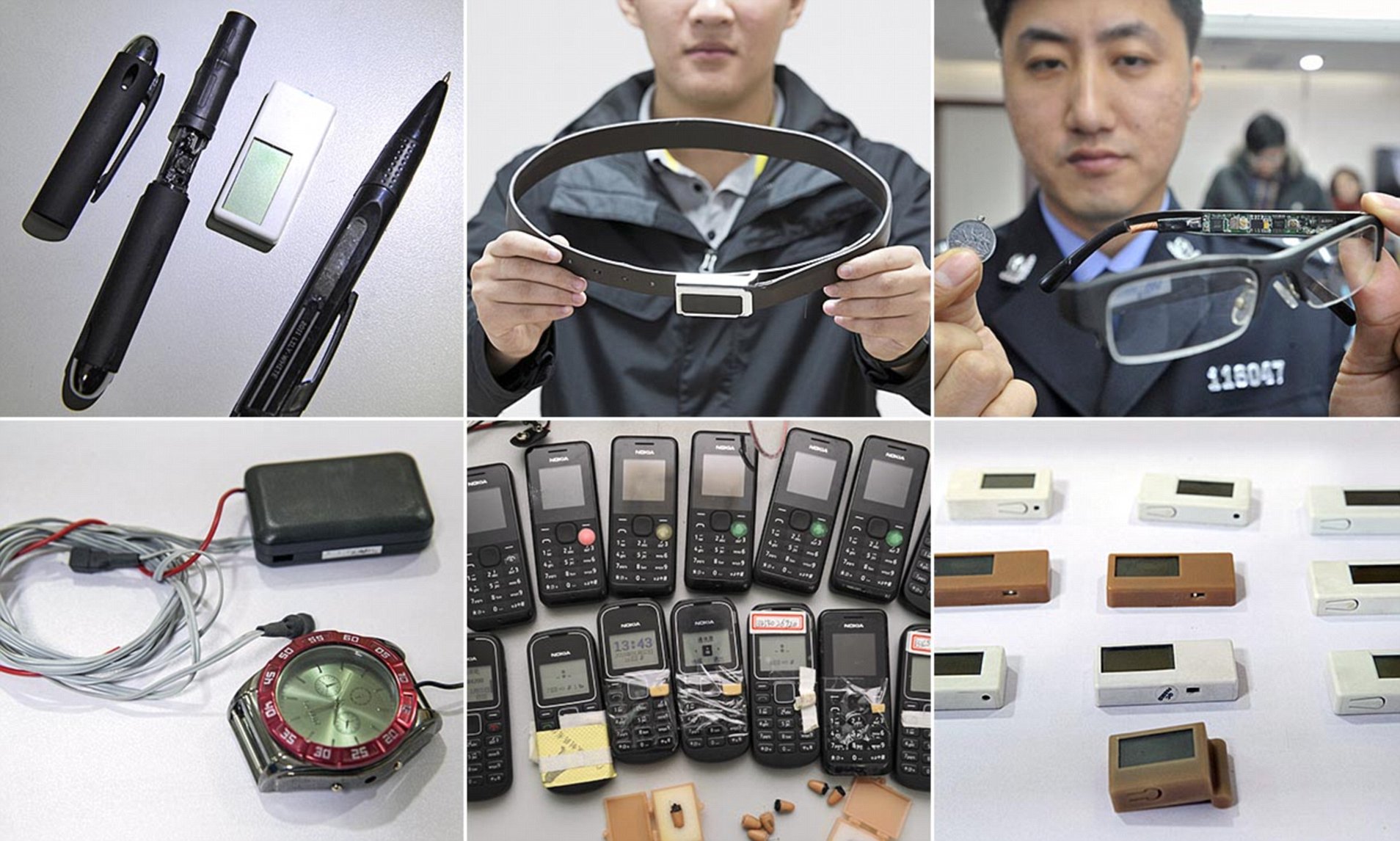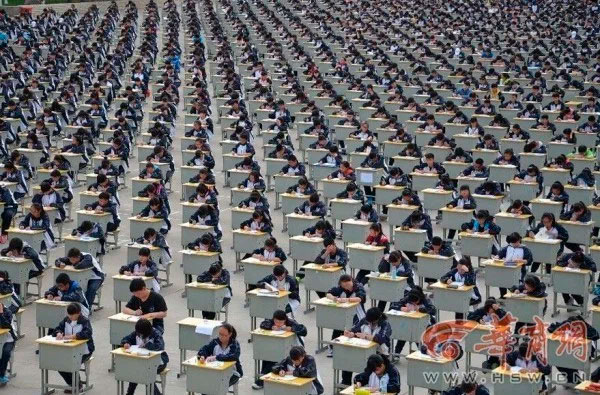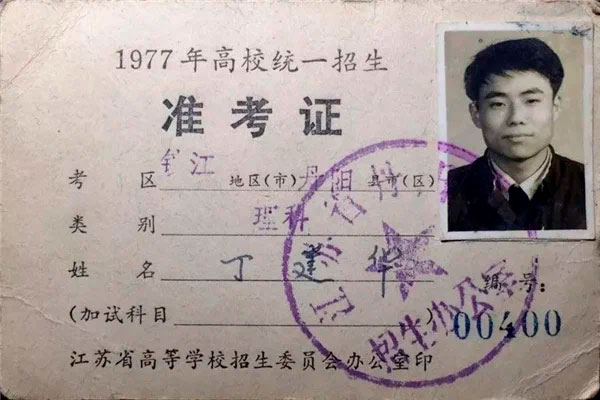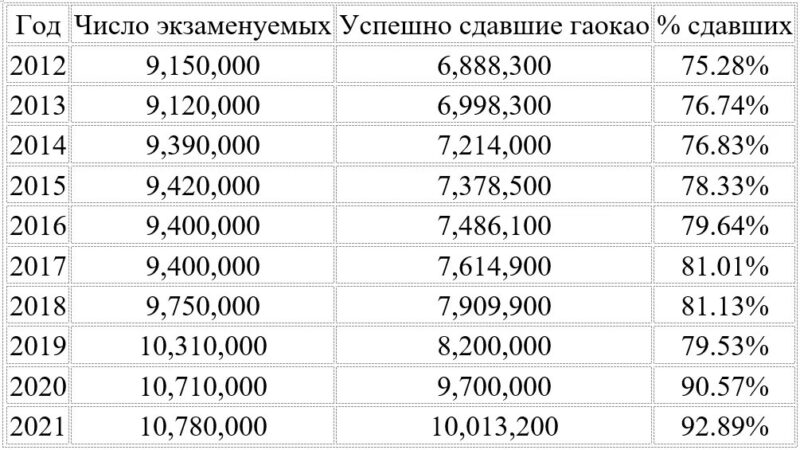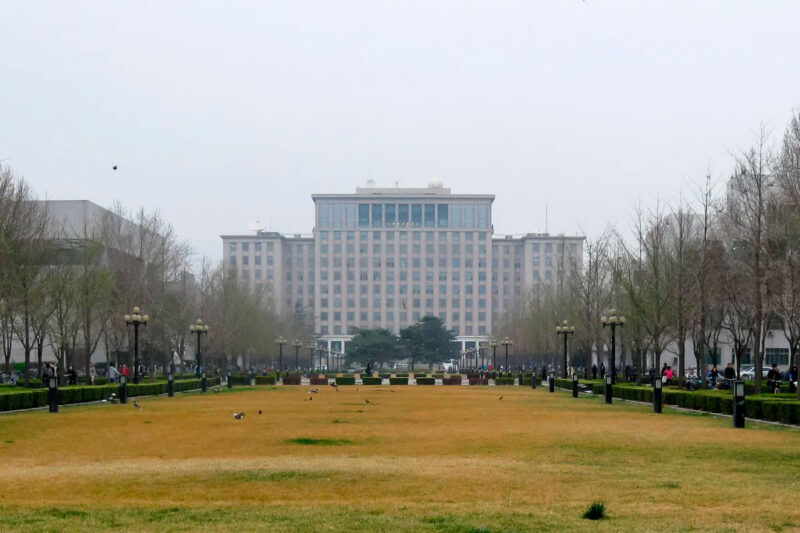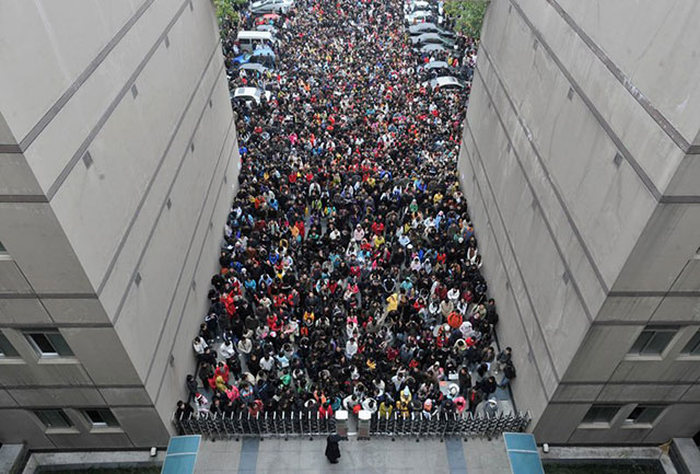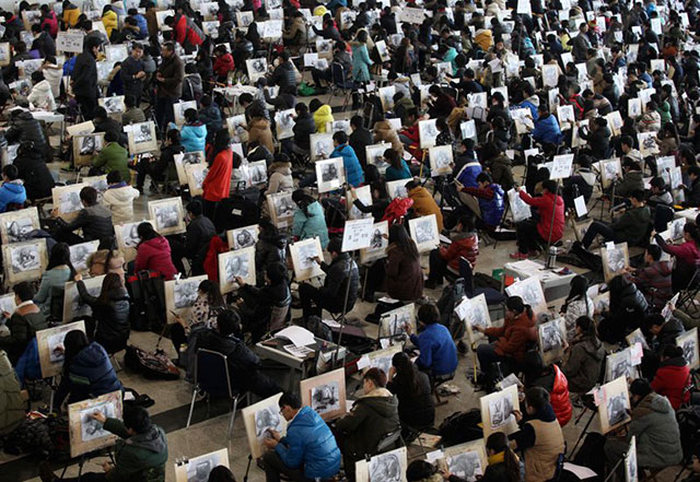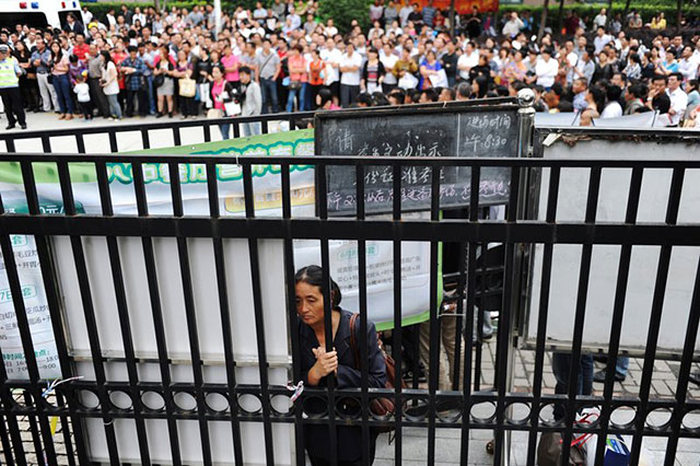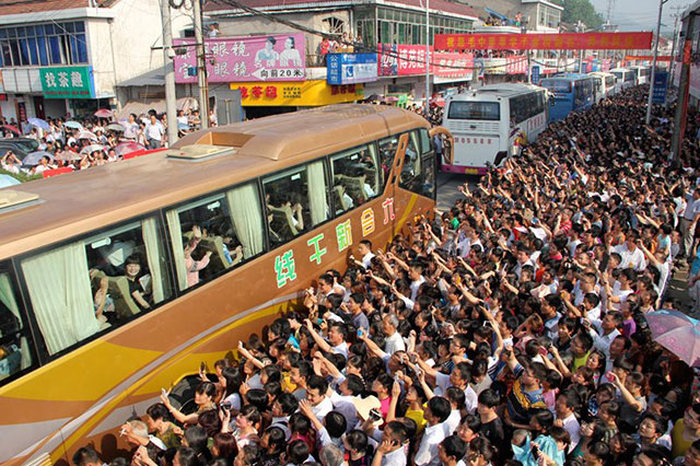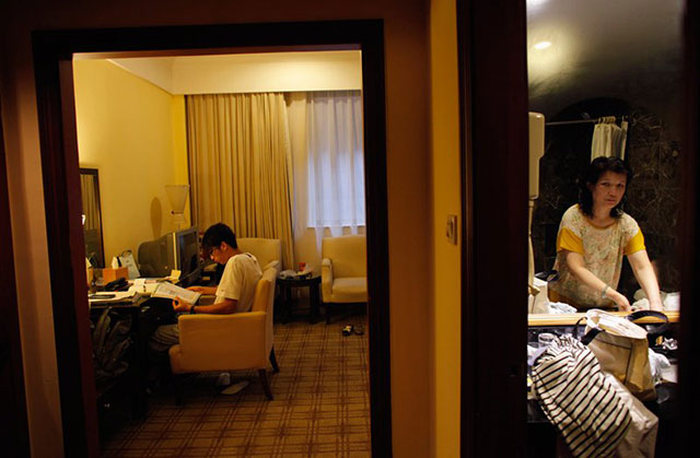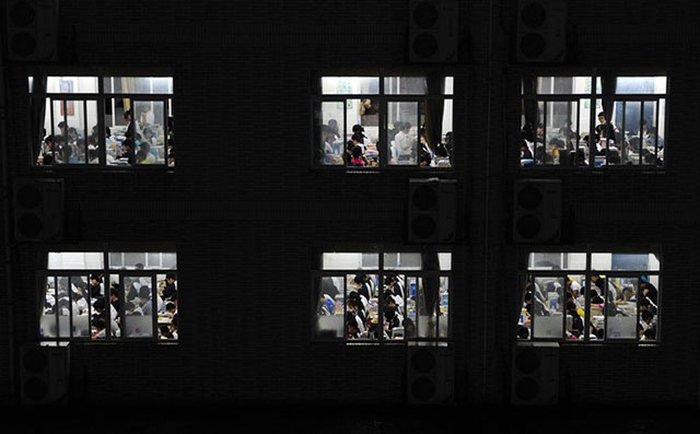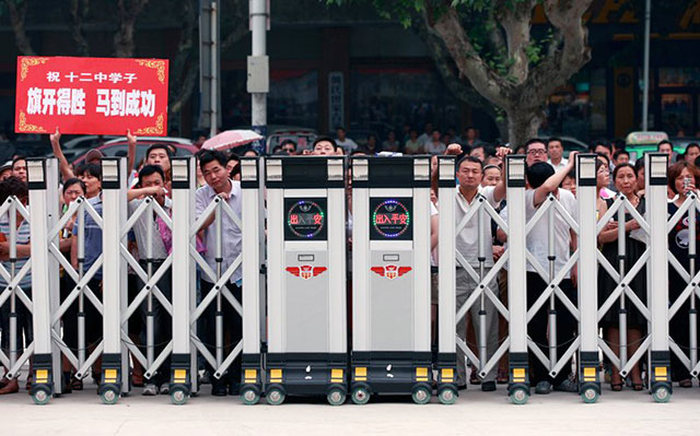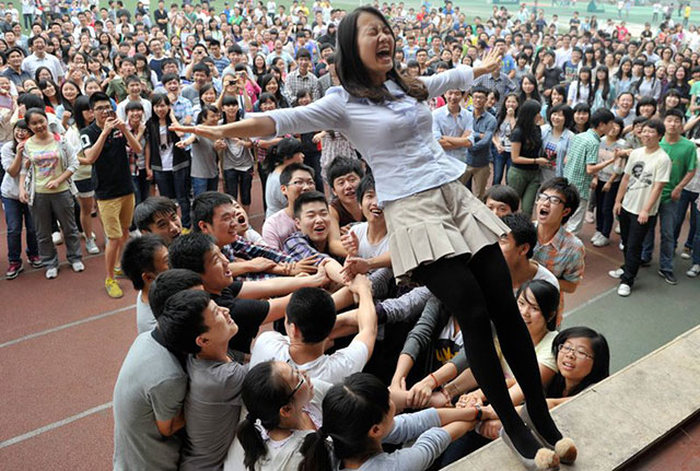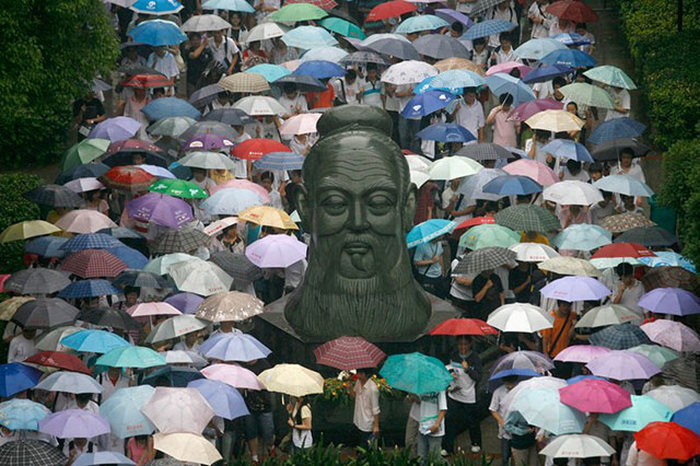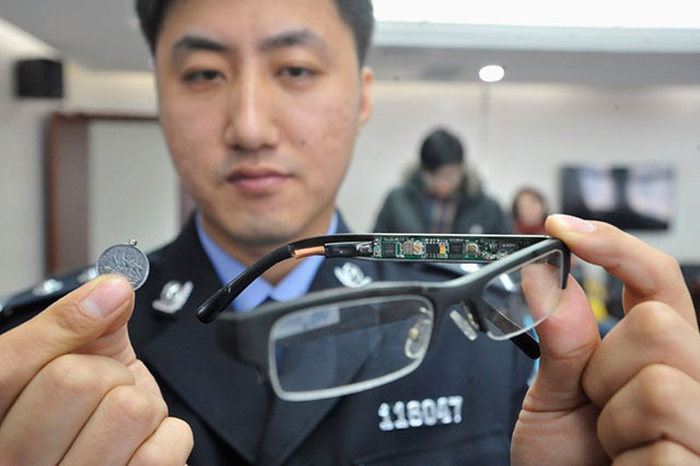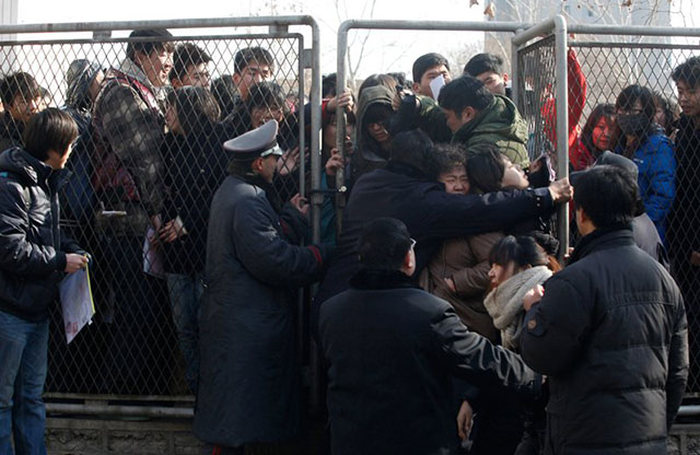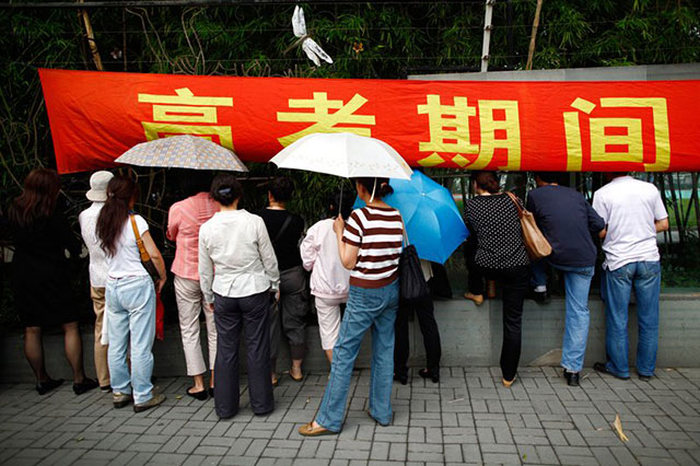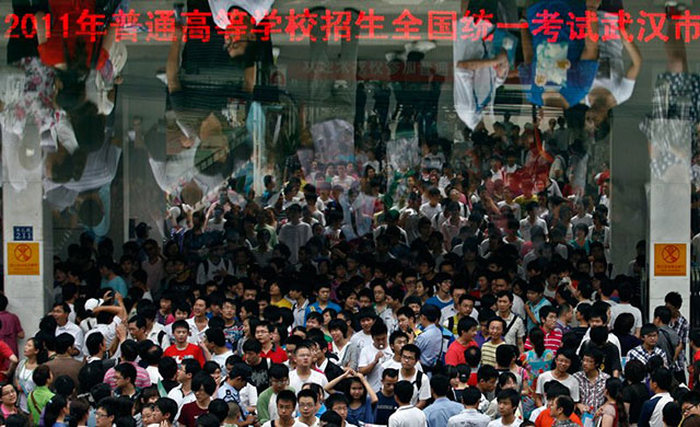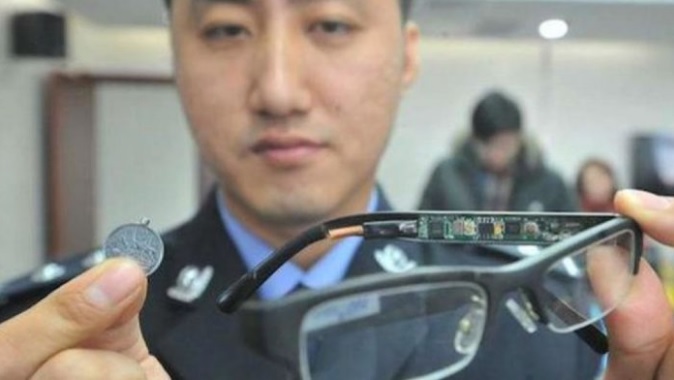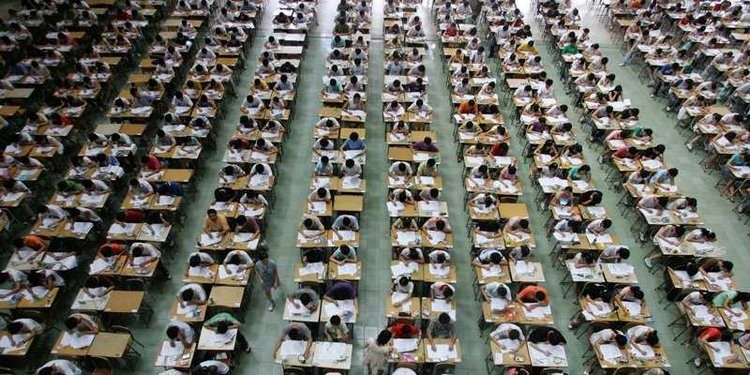
Российские выпускники для поступления в вузы сдают пугающий ЕГЭ, а в Китае сдают ужасный гаокао (高考 gāokǎo). Это важнейший единый государственный экзамен, необходимый китайцам для поступления в вузы материкового Китая. Ежедневный стресс при изнуряющей подготовке, бессонные ночи школьников, безумные финансовые вложения родителей в надежде на успешную сдачу экзамена — это и есть знаменитый на весь мир гаокао. Подробнее о печально известном экзамене написали SupChina.
Каждый год в начале июня Китай ненадолго замирает. А все потому, что китайские выпускники сдают гаокао. В этом году из-за пандемии коронавируса единый экзамен перенесли ровно на месяц — в 2020 его будут сдавать 7 и 8 июля.
Однако несмотря на необычные обстоятельства и отсрочку, ставки очень высоки. Печально известный двух- или трехдневный экзамен (длительность варьируется в зависимости от провинций) в июле напишут 10 млн ребят, отчаянно желающих поступить в престижные вузы Китая. Чем выше баллы гаокао, тем ближе становится блестящее будущее и впечатляющая зарплата во взрослой жизни. А для студентов из более бедных сельских районов высокие баллы означают и шанс полностью изменить свою жизнь и жизнь всей своей семьи.
Что такое гаокао?
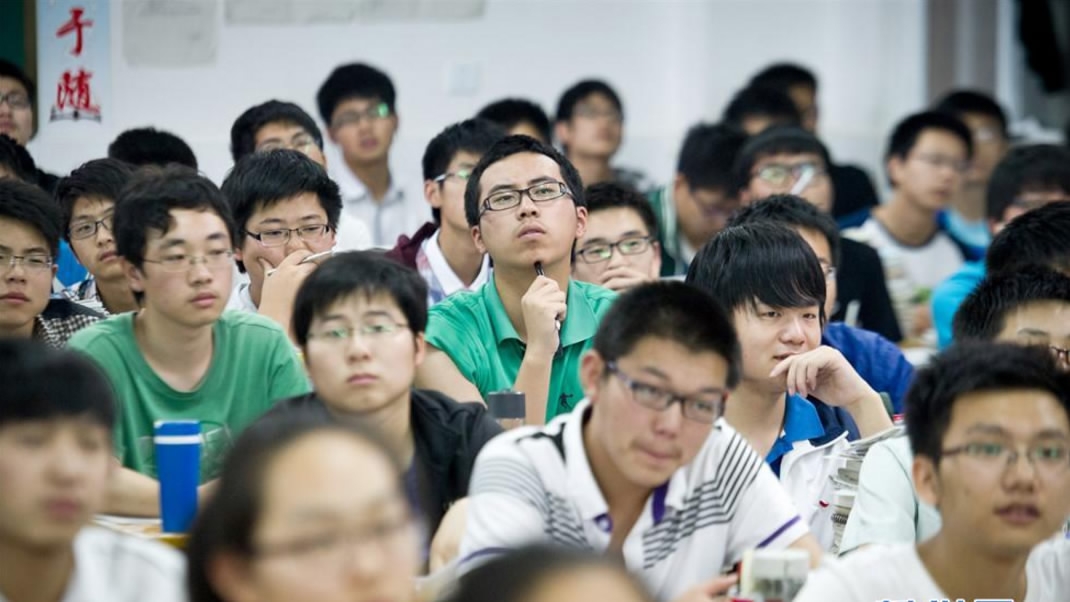
В первую очередь это практически единственный критерий, по которому китайские вузы отбирают себе студентов. И хотя вопросы несколько отличаются в зависимости от провинций, все они проверяют знания студентов в таких сферах, как китайская литература, математика и иностранный язык (чаще всего английский). Помимо трех обязательных предметов студенты также сдают три предмета по выбору.
Одновременно с этим школьникам также предстоит заполнить форму и перечислить университеты, в которые они хотели бы поступить. Каждое китайское высшее учебное заведение устанавливает нижний проходной порог, однако для учеников из разных провинций баллы могут варьироваться.
Например, если ученик сдает гаокао в густонаселенной провинции, ему будет сложнее поступить в хороший вуз. Из-за большой конкуренции неизбежно будет расти и минимальный проходной балл. Совсем другое дело в провинциях с небольшой плотностью населения. Там проходные баллы в университеты будут ниже, а значит и поступить в них будет легче.
Если же вы житель крупного города, у вас есть кое-какие преимущества для поступления в лучшие заведения страны. Согласно Berkeley Political Review, местным ученикам при поступлении отдается предпочтение. Поэтому жителям Пекина или Шанхая, где сосредоточены элитные учебные заведения, будет несколько проще в них поступить.
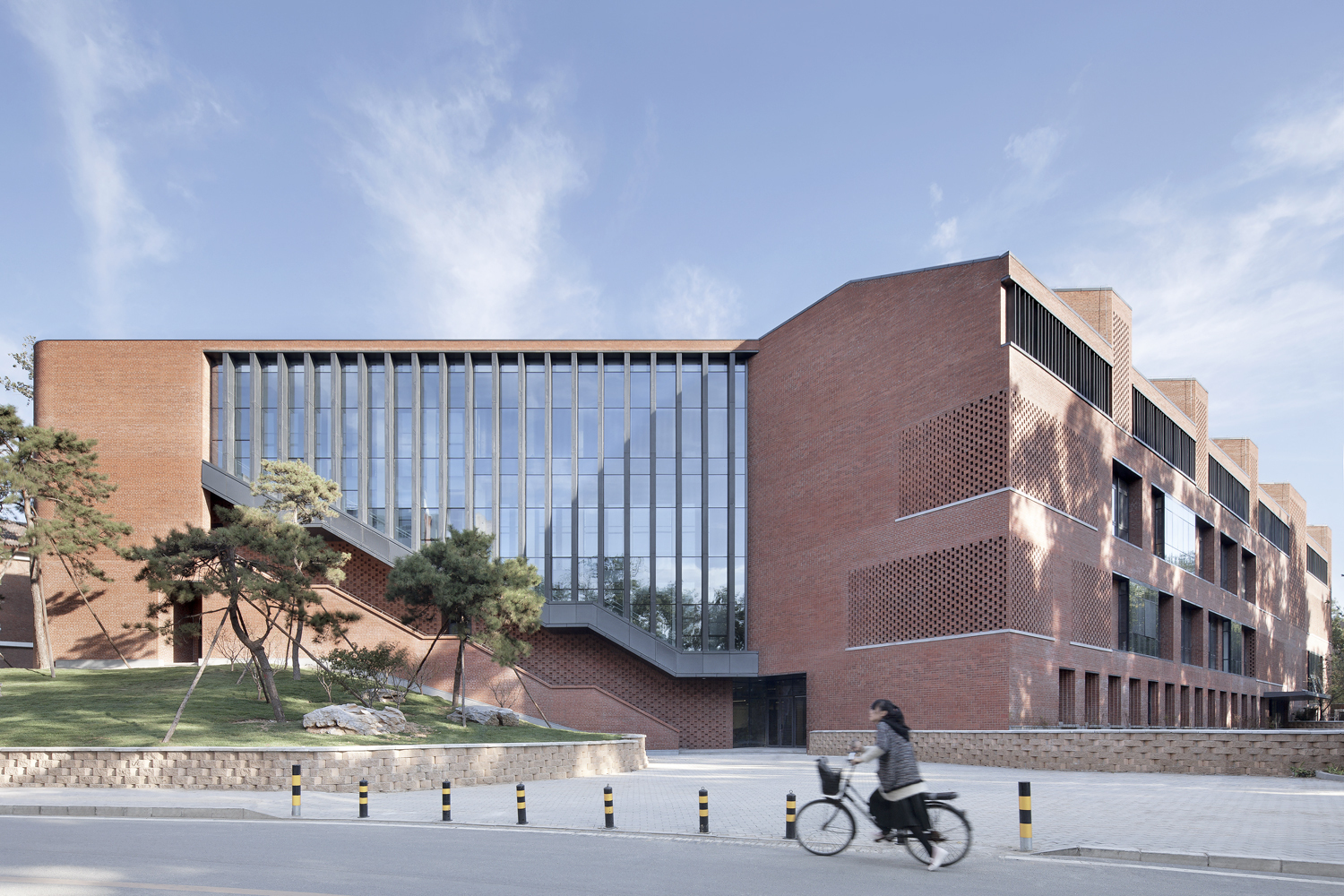
Фото: ArchDaily
Если у вас высокий балл, вы можете попасть в первый вуз из вашего списка. Если же баллов не хватает, вашу анкету отклонят и передадут в следующее по списку заведение. Нельзя не признать, в Китае конкуренция при поступлении просто немыслимая. В лучшие университеты порой принимают менее 1% подавшихся кандидатов.
В таких условиях, конечно, есть и те, кого не приняли ни в один вуз. Они теряют возможность поступления в университет на один год. Однако для них есть и в чем-то хорошая новость. Гаокао можно сдавать неограниченное количество раз, и пытаться, пытаться, пытаться.
Как проходит подготовка к гаокао
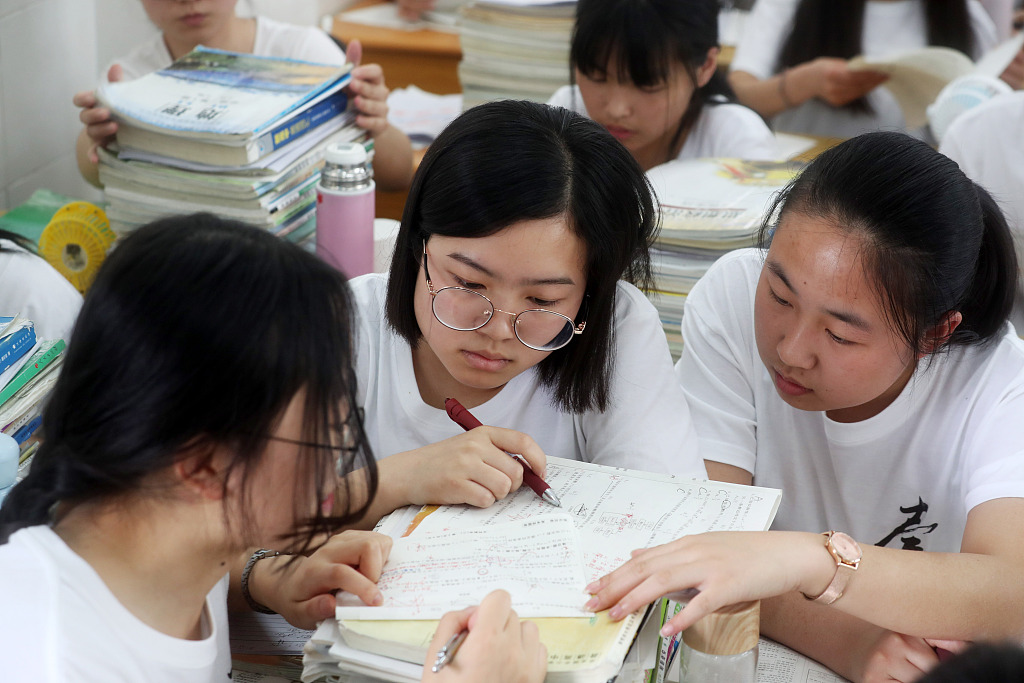
Для школьников гаокао — это одновременно маячок надежды и предмет страха. Обычно, весь последний год обучения у ребят уходит на лихорадочную подготовку. Многие из них посещают специальные подготовительные курсы, где по 16 часов в день корпят над книгами. Однако весь период подготовки старшеклассники страдают не одни. Тяжелый груз ложится и на плечи их родителей.
Китайские родители зачастую вкладывают все свои ресурсы, надеясь на успешную сдачу гаокао своими детьми. Некоторые уходят с работы на год, чтобы хоть как-то курировать подготовку детей к гаокао.
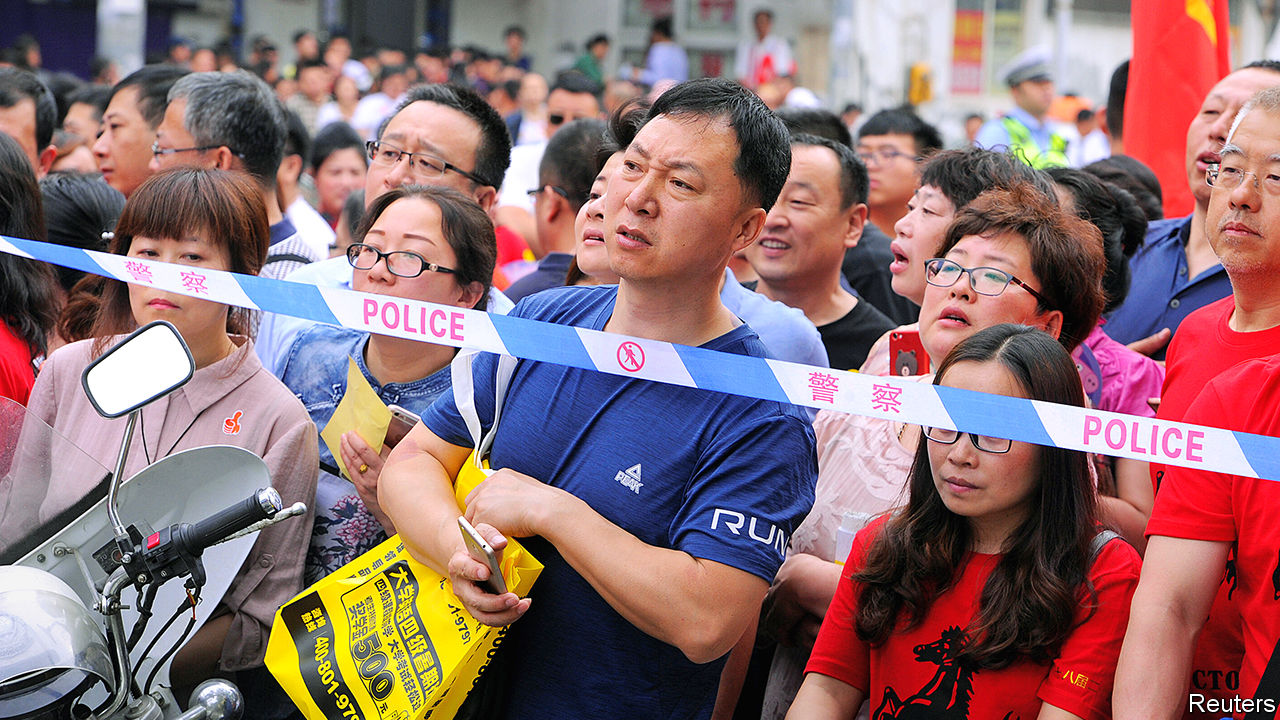
Когда наступает день экзамена, страна буквально замолкает. Вблизи школ водителям запрещено сигналить, автобусы не должны транслировать аудиосообщения на остановках. Местных жителей просят по возможности разгрузить дороги и избежать поездок в часы пик, чтобы уменьшить для школьников вероятность опоздания. А в некоторых городах ребята даже получают возможность проходить в метро вне очереди в дни экзаменов.
Списывание на гаокао
Фото: The Economist
Ставки для школьников на экзамене настолько высоки, что каждый год в Китае не обходится без уже привычного скандала. Сдающие тест пытаются пользоваться маленькими наушниками и даже нанимают людей, готовых написать работу за них. В эти дни в Китае растет спрос на самые разные беспроводные приспособления для списывания.
В ответ на нечестное поведение власти расставляют металлоискатели, активируют приборы для распознавания лиц, привлекают дроны и наряды полиции. Все, чтобы гарантировать надлежащий надзор за местами проведения экзаменов. А любой школьник, попавшийся на списывании, будет на несколько лет лишен возможности сдать гаокао. Если же кого-то поймают на организации массового списывания или узнают, что кто-то нанял другого сдать экзамен за себя, то мошенника лишением свободы до 7 лет.
Экзаменационные бланки и задания перевозят как самые секретные документы. При транспортировке их сопровождает охрана и отслеживают по GPS. Преподаватели, которые составляли задания, находятся под строгим наблюдением, чтобы избежать утечки информации.
Реформирование гаокао
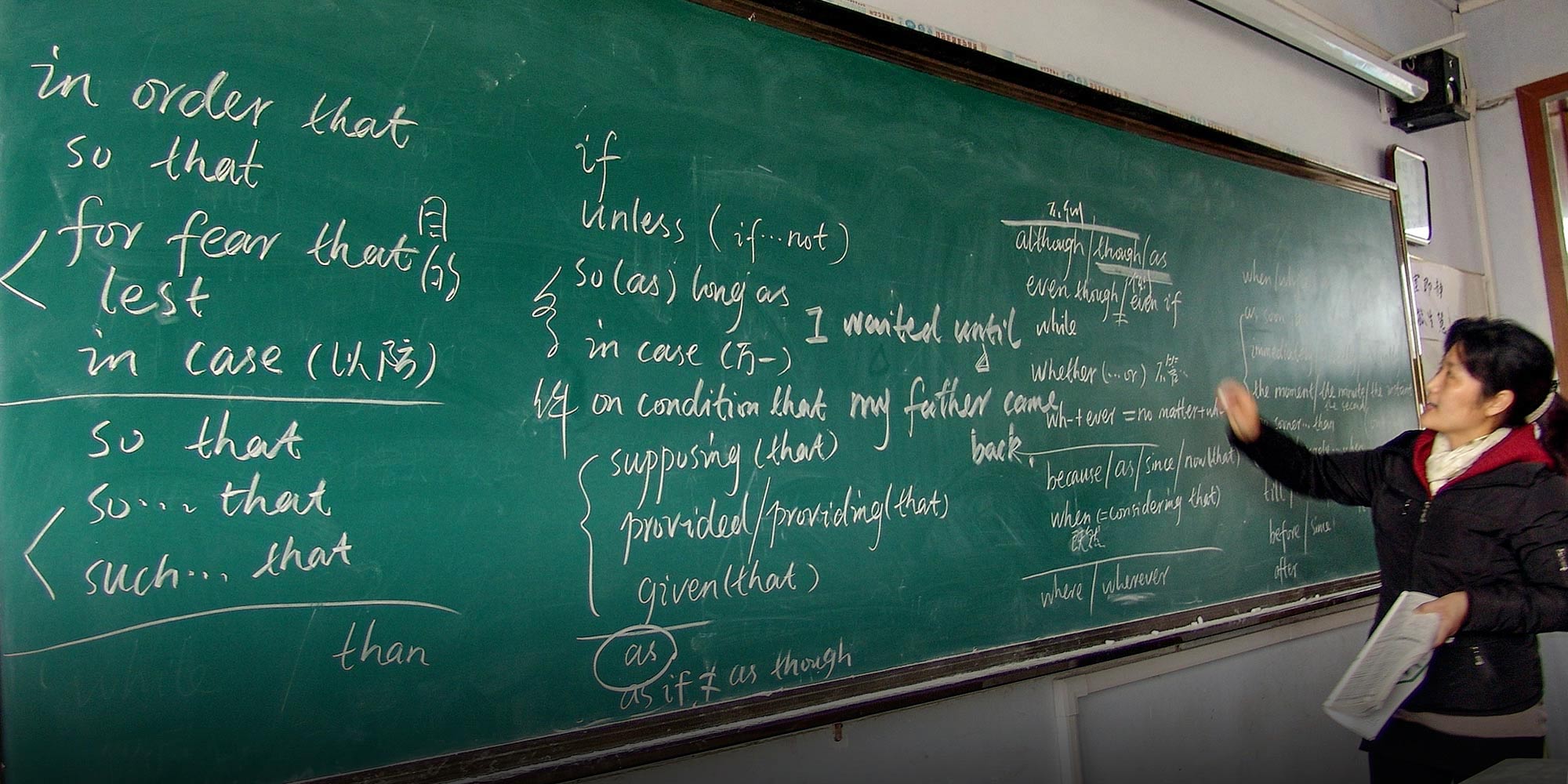
Гаокао должен был стать справедливым решением в сложном вопросе приема в вузы. Однако экзамен часто критикуют за обесценивание творческого подхода и индивидуальности каждой личности. Критики экзамена считают, что гаокао сводит умения и знания учащегося к ничего не означающей цифре.
В ответ на недовольство правительство КНР из года в год проводит реформирование гаокао. В 2003 году в Китае параллельно запустили еще одну программу по отбору студентов. Она должна была дать возможность лучшим университетам страны напрямую принимать к себе учеников, отличившихся в той или иной сфере. К примеру, публиковавшийся в журналах или выигравший олимпиаду школьник мог быть сразу зачислен в престижный китайский университет.
Однако данную программу тоже раскритиковали. Некоторые утверждали, что она дает преимущества лишь обеспеченным студентам, ведь у них больше шансов выделиться в какой-либо сфере. В 2019 году правительство установило ограничения на количество студентов, которых университеты могут принять по этой программе. А в 2020 программу планируют заменить другой. Главная цель новой программы — решить проблему неравенства при зачислении в вузы. При этом 85% абитуриентов все также будут оцениваться по баллам гаокао.
В 2018 Китай также упразднил систему бонусов при поступлении, и теперь ученики не могут получить дополнительные баллы за успехи в спорте или звание «лучшего студента» в провинции.
В 2014 году ребятам из некоторых регионов предоставили свободу в выборе дополнительных предметов. Раньше необязательные предметы на сдачу можно было выбрать лишь из одной категории (гуманитарные или естественные научные дисциплины). Сейчас студенты могут сдавать любые предметы: физику, химию, биологию, географию, политику, историю и общие технологии.
Еще одно нововведение: теперь попытаться сдать гаокао по дополнительным дисциплинам можно за год до официальной сдачи. То есть не на третьем, а на втором году старшей школы. Однако обязательные предметы (китайский, математику и английский) можно будет сдать лишь в конце третьего года обучения. Есть и еще одна хорошая новость: все необязательные предметы плюс английский можно сдавать два раза. В таком случае в итоге будет учтен лучший результат.
Эти разные по важности и эффективности реформы все еще находятся на этапе эксперимента и не действуют по всей территории страны. Например, в июне 2020 года в Китае заявили о ужесточении льготной политики при поступлении для иностранцев.
Важно отметить, что в последние годы число сдающих гаокао студентов неизбежно сокращается. Согласно Global Times, в 2016 году это сокращение было отмечено уже десятый год подряд. Такая тенденция может быть связана с политикой «одна семья — один ребенок», которая вступила в силу в 1978 году и привела к снижению рождаемости. Однако возможно, все больше студентов выбирают образование за рубежом и готовятся к международным экзаменам, а не к гаокао.
Если хотите попробовать свои силы в гаокао, решите наш ТЕСТ: Сможете ли вы пройти китайский ЕГЭ.
Подготовила Полина Ширяева
Каждый год выпускники российских школ сдают ЕГЭ. И хотя этот экзамен является обязательным уже более 10 лет, до сих пор не утихают споры относительно его целесообразности. Одна из основных претензий к ЕГЭ — тот стресс, который испытывают школьники и их родители, пока готовятся к экзаменам и в дни сдачи экзаменов. Однако сложность нашего ЕГЭ и все переживания вокруг него — лишь жалкое подобие того, через что приходится проходить выпускникам китайских школ.
Гаокао 高考 gāokǎo (досл. «высокий экзамен») — сокращение названия «Единый государственный экзамен для поступления в высшие учебные заведения обычного типа» 普通高等学校招生全国统一考试 pǔtōng gāoděng xuéxiào zhāoshēng quánguó tǒngyī kǎoshì. Завершился изнурительный период, когда вся жизнь молодых китайцев была подчинена только одному: подготовке к гаокао. В это время школьник может посвящать учебе 16 и более часов в сутки. Неудивительно, что многие не выдерживают такого ритма.
Современная система гаокао имеет два источника. Первый — признание экзаменационной системы, история которой насчитывает в Китае более 2000 лет, безусловной общественной ценностью. Второй — западная экзаменационная система.
- По теме: Китайская экзаменационная система кэцзюй
Впервые единые экзамены ведущие китайские университеты (Пекинский, Цинхуа и т.п.) начали проводить в 1930-е годы. Однако дальнейшему ее развитию помешала начавшаяся в 1937 году японо-китайская война, которая продлилась до 1945 года. Возобновились единые экзамены только в 1952 году, после основания Китайской Народной Республики.
После начала Культурной революции в 1966 году единый экзамен был заменен системой рекомендации рабочих, крестьян и солдат. Одновременно началось движение «Вверх в горы, вниз в села» 上山下乡运动 shàngshān xiàxiāng yùndòng, городскую молодежь отправляли на трудовое воспитание в сельскую местность. Деятельность университетов была приостановлена и возобновилась только в начале 1970-х годов. Однако решение о поступлении в то время принималось не на основании академической успеваемости абитуриента, а созданными в годы Культурной революции Революционными комитетами 革命委员会 gémìng wěiyuánhuì.
После смерти Мао Цзэдуна (9 сентября 1976 года) система единых экзаменов была возобновлена. Первые такие экзамены состоялись в конце 1977 года. Уровень образования и возраст не ограничивались. Результаты были плачевными: из 5,7 миллионов человек, сдававших экзамен, в вузы поступили только 272.971 человек, из которых 63.000 — по квоте. Это был самый низкий уровень в истории КНР уровень приема в вузы — 4,8% от числа желающих.
В настоящее время в гаокао входят три обязательные для всех дисциплины — китайский язык, математика и иностранный язык, а также блок предметов естественнонаучного или гуманитарного профиля, которые зависят от направления подготовки школьников (системы «3+X», «3+2» и т.д.). В разных провинциях и автономных районах Китая, а также для национальных меньшинств содержание гаокао может несколько отличаться. В зависимости от того, какой профиль выбрал школьник в средней школе высшей ступени (高中 gāozhōng, 10-12 классы) — гуманитарный или естественнонаучный, он прекращает изучать предметы по другому профилю и сосредотачивается на своем; однако этот выбор влияет на всю его дальнейшую карьеру.
Формально гаокао представляет собой тест с вопросами закрытого и открытого типа. Однако даже чтобы выбрать правильный вариант ответа из предложенных, требуется подключить свои знания и логику. Также ученики пишут эссе на заданную тему.
В 2021 году экзамен проводился 7 и 8 июня. За два дня почти 11 миллионов выпускников школ и людей более старшего возраста сдали четыре экзамена:
1-й день:
- с 9:00 до 11:30 — китайский язык и литература (макс. 150 баллов);
- с 15:00 до 17:00 — математика (макс. 150 баллов);
2-й день:
- с 9:00 до 11:30 — гуманитарные науки (история, политология, география) / естественные науки (физика, химия, биология) (макс. 300 баллов);
- с 15:00 до 17:00 — иностранный язык (макс. 150 баллов).
Максимальное количество баллов, которое может набрать экзаменующийся — 750. Национальным меньшинствам и некоторым категориям лиц могут начисляться дополнительные баллы.
Во время экзамена здание школ оцепляется полицией и армией во избежание эксцессов. Проезжающим мимо водителям запрещается подавать звуковые сигналы, в ряде мест движение автотранспорта вовсе перекрывается. На экзамене никакие шпаргалки не допускаются, провинившийся изгоняется с позором и на три года лишается права сдавать гаокао. В некоторых районах за списывание предусматриваются и более суровые наказания.
Как много человек сдают гаокао успешно? Это можно увидеть из таблицы за последние 10 лет. До этого процент сдавших экзамен постепенно увеличивался с 4,74% в 1977 году до 73,04% в 2011 году.
Чем выше итоговый балл, тем в более престижный вуз может поступить вчерашний школьник. А от этого зависит вся дальнейшая жизнь, карьера и доход.
Далеко не все китайские школьники готовы выдержать сложности, связанные с подготовкой и сдачей гаокао. Поэтому некоторые из них после 9 класса (обязательное неполное среднее образование) уходят в средние профессиональные учебные заведения, либо после окончания школы поступают в платные вузы в Китае или зарубежные вузы.
© Сайт «Дорогами Срединного Пути», 2009-2023. Копирование и перепечатка любых материалов и фотографий с сайта anashina.com в электронных публикациях и печатных изданиях запрещены.
Ежегодно в начале июня миллионы выпускников школ со всего Китая сдают единый вступительный экзамен в ВУЗы страны, который называется «Гаокао». Для большинства молодых людей – это единственный шанс получить высшее образование, причем по китайским законам абитуриент может подать документы только в один ВУЗ. В течение двух дней необходимо сдать китайский язык, литературу, математику и некоторые другие предметы, в зависимости от выбранной специальности. Оценка, полученная на стандартизированном экзамене «Гаокао», определит будущую жизнь китайских парней и девушек, а потому на экзамене царит нешуточный накал страстей.
Абитуриенты на экзамене по английскому языку в университете города Дунгуань, провинция Гуандун.
Студенты рисуют эскизы. Цзинань, провинция Шаньдун.
Мать ждет ребенка с экзамена в городском округе Хэфэй, провинция Аньхой.
Студентов везут на экзамен. Город Луань, провинция Аньхой.
Абитуриент Zheng Dong готовится к экзамену в гостиничном номере Шанхая.
Наблюдатели следят за тем, чтобы будущие студенты не списывали. Городской округ Суйнин, провинция Сычуань.
Вчерашний школьник отдыхает на подготовке к самому ответственному экзамену в его жизни.
Студенты самостоятельно готовятся к экзамену. Хэфэй, провинция Аньхой.
Родители дожидаются своих детей. Хуайбэй, провинция Аньхой.
Абитуриенты сбрасывают напряжение перед экзаменом.
Экзаменующиеся просят помощи у великого мыслителя древности Конфуция.
Проверка бывших школьников перед экзаменом. Шэньян, провинция Ляонин.
Изъятые у недобросовестных абитуриентов девайсы: скрытая камера в пишущей ручке и приемник, замаскированный под резинку.
Очки с видеокамерой и приемник в монете.
Более сложное устройство.
Изъятые мобильные телефоны и приемники. В качестве наказания запрещается повторно сдавать экзамен в течение максимум 3-х лет.
«Группа поддержки» подбадривает бывших учеников школы №2 города Хэншуй, провинция Хэбэй.
Студенты пытаются прорваться сквозь заграждение на регистрацию перед экзаменом.
Родители в Шанхае ждут своих детей.
Абитуриенты выходят из здания после окончания первого дня экзаменов.
Проверка будущих студентов перед экзаменом.
Студенты надели кислородные маски во время подготовки.
Каждый год порядка 8 млн китайских юношей и девушек подают заявления о поступлении в высшие учебные заведения, но мест в университетах хватает примерно половине из них. В стране с более чем миллиардным населением идет настоящая «война без крови и пуль» – молодые люди сражаются друг с другом за право получить лучшее образование. Поле битвы – школьные классы, оружие – память и железная воля, решающее сражение – выпускной экзамен, гаокао («большой тест»), аналог ЕГЭ.
С тех пор, как в 1981–1982 годах китайское правительство перешло к политике жесткого ограничения рождаемости, единственный ребенок в семье стал средоточием всех сил и стремлений старших поколений. По вековой традиции он должен обеспечить родителей в старости, а потому получение им хорошего образования – залог выживания и благополучия всей семьи. В стране с населением более 1 млрд человек борьба за места в университетах напоминает жесточайшую гонку на выживание. В 2005 году гаокао сдавали 8,67 млн человек, претендовавших на 5,04 млн мест для приема в университетах, в 2008 году – 10,5 млн человек и 5,99 млн соответственно[1].
Принимают в университеты на основе экзамена гаокао, аналогичного российскому ЕГЭ. Китайские школьники сдают три обязательных предмета – математику, китайский и английский плюс комплексный экзамен из трех предметов на выбор (политология, география, история для гуманитариев и физика, химия, биология для технарей). Подготовка к гаокао полностью занимает последний год старшей школы, новых знаний они не получают, а вызубривают и отшлифовывают пройденное. «Тюрьма», через которую приходится пройти подросткам 17–19 лет, чтобы стать успешными и уважаемыми членами общества, вызывает много критики и недовольства у взрослых китайцев.
«Давление в последний год школы очень сильное… Все знают, что этот год самый важный в жизни, и очень серьезно к этому относятся. Учителя, которых школа выбирает для выпускных классов, самые способные и знающие, возятся с детьми не хуже родителей. Помогают думать, решать разные проблемы, за каждым учеником ходят, сообщают, сколько баллов он получил за последнюю работу, расспрашивают, что и как. Это только кажется, что целый год готовиться к одному-единственному экзамену – слишком долго. Я тогда так много учился – ни до, ни после, никогда больше так не учился». «Каждую неделю у нас были экзамены по одному-двум предметам, а раз в месяц – официальный пробный экзамен по всем сразу. Итого большой пробный экзамен мы сдавали 6 раз». «Это как тюрьма. Есть школы, где последние три года минимум по 12 уроков в день. И все ради того, чтобы поступить в самый лучший университет. У людей нет свободы, нет интересов, ничего нет. Ни в футбол играть, ни музыку слушать, ни с девушками общаться – ничего нельзя, потому что нет времени. Конкуренция. Сидят и занимаются все время» (У Жуй-чэн, выпускник).
Гаокао сдают три дня. Например, в первый день утром – математика, вечером – китайский, во второй день утром – английский, вечером – комплексный экзамен по научному или гуманитарному профилю. Максимально можно набрать 750 баллов (по 150 баллов за каждый из обязательных предметов и 300 баллов за «комплекс»). Экзамен по обязательным предметам длится 2 часа, экзамен по выбору – 1,5 часа. Если экзаменуемый не уложился в отведенное для теста время, то экзамен считается несданным.
Списывание, мобильные телефоны, электронные «гаджеты», разговоры и т. п. во время экзамена строго запрещены. На входе всех обыскивают, в том числе металлоискателем. Попавшегося на списывании лишают права сдавать гаокао в течение трех лет. 1 ноября 2015 года вступили в силу поправки в Уголовный кодекс КНР, согласно которым мошенничество на гаокао считается уголовным преступлением, за которое можно получить до 7 лет тюремного заключения. В дни экзамена специальные службы ведут круглосуточный мониторинг интернет-пространства, чтобы не допустить попадания в сеть информации, касающейся проходящего экзамена.
Утром в день сдачи гаокао дорожная полиция традиционно обращается к горожанам с призывом отказаться от личного транспорта, пересесть на автобусы и метро, чтобы не препятствовать движению школьников, которые сдают экзамен в специальных экзаменационных пунктах города. Родители, как правило, берут отгулы или отпрашиваются на работе, чтобы проводить своих выросших детей на экзамен, а потом переживать под стенами экзаменационных центров. Напряжение во время экзамена столь высоко, что в экзаменационных пунктах всегда дежурят врачи.
Это безумие иногда заканчивается трагедией. За неделю до экзамена появляются длинные очереди на прием к врачам традиционной китайской медицины и психологов. Абитуриенты составляют более 30% всех пациентов. Они жалуются на повышенную нервозность, нарушение сна, нервное истощение. Сообщения о самоубийствах на почве неудачи в экзамене гаокао появляются в китайских СМИ практически каждый год. Так, юноша опоздал на экзамен и в отчаянии выбросился из окна здания, где находился экзаменационный пункт. 19-летняя девушка бросилась с моста в реку, не набрав в третий раз требуемую сумму баллов. Слишком велика нагрузка на подростковую психику, страх не сдать экзамен живет в ребенке с первого класса.
Задачи вступительного экзамена не во всех провинциях одинаковы. Менее развитые, например Тибет или Цинхай, используют более простой вариант, богатые восточные – вариант посложнее. Помимо этого избыток интеллектуальной массы с востока отсеивают жестким отбором. Для того чтобы поступить в университет первого уровня, жителю северо-восточного Шаньдуна надо набрать 630 баллов, представителю Синьцзян-Уйгурского автономного района – 530, а школьнику из Тибета – 400. К результату экзамена добавляются баллы за реальные достижения (например, победа в олимпиаде «стоит» около 20 баллов) и политически ценные качества вроде происхождения или национальности. В Китае официально насчитывается 56 национальностей, причем ханьцы составляют примерно 92% населения, а остальные народы считаются национальными меньшинствами. Чем меньше численность нацменьшинства, тем большими привилегиями при поступлении в университеты пользуются его представители. Так, уйгурам к результату экзамена добавляют 60–80 баллов, маньчжурам – только 10, потому что они мало чем отличаются от ханьцев, дунганам – тоже 10, потому что дунган много. А вот школьнику из народа численностью 10–20 тыс. человек могут и 100 баллов добавить.
Кроме несправедливой системы начисления баллов, молодых китайцев возмущает непредсказуемость процесса отбора в вузы. Приходится «делать ставки» вслепую, толком не зная своего результата. Спустя два дня после экзамена в школу приходят ответы на незначительную часть заданий, потому что длительной проверки требует не только сочинение по китайскому языку, но и задачи по математике (в китайской системе образования принято оценивать не только результат, но и весь ход решения), а также практически все задания комплексного экзамена. На основании этих куцых данных нужно примерно прикинуть свой балл и подать заявление о поступлении в четыре университета.
В Китае все университеты делятся на четыре уровня, в заявлении надо указать по одному университету каждого. Самый высший уровень нулевой. Это закрытые университеты, готовящие специалистов для армии и правительства. О них нет никакой информации, кроме названия (даже проходные баллы за прошлые годы не узнаешь). Поступить туда сложнее всего, кроме отличных результатов на экзамене, нужно соответствовать другим требованиям. Тем не менее, абитуриенты в анкете указывают один университет этого типа.
Университеты первого уровня – главные университеты страны, правительство не жалеет на них денег… Чем ниже уровень университета, тем меньше денег он получает от государства, и тем большую долю его доходов составляет плата за обучение. Учась в университете первого уровня, студенты получают приличную стипендию, а в менее престижном вузе они сами оплачивают обучение. Тем самым государственное участие оказывается естественным маркером качества образования: окончившие университет первого уровня могут рассчитывать на самые лучшие рабочие места. «Дипломам частных вузов не доверяют, потому что их можно купить. Если у тебя богатая семья, ты можешь окончить такой вуз и получить работу от папы. А если ты хочешь работать в компании, то тебя не возьмут» (У Жуй-чэн).
Правильно выбрать по одному университету каждого уровня – задача нетривиальная. Проходной балл в китайские университеты заранее не известен. Допустим, университет планирует набрать 800 первокурсников, тогда результат последнего принятого и окажется проходным баллом. «Тут как с акциями: в этом году спрос на университет большой, и его „акции“ растут в цене. А на следующий год все испугались, спрос упал – и проходной балл стал ниже. Поэтому родители читают специальные журналы для поступающих, где публикуются сведения о всех университетах, проходные баллы за предыдущие годы, высчитываются средние…» (У Жуй-чэн).
Анкеты абитуриентов поступают в единую систему. Первыми доступ к этой базе данных получают университеты нулевого уровня, в течение недели они «снимают сливки». Данные отобранных ими абитуриентов изымают из системы. Далее тоже делают университеты первого уровня, затем университеты второго и третьего уровней. Поэтому плохо ошибиться с выбором уровня университета. «Я примерно оценил свой результат максимум в 460 баллов, поэтому университет первого уровня выбирал несерьезно (Северо-Западный сельскохозяйственный университет в Сиане), думал, что точно поступлю на университет второго уровня – Архитектурный в Чунцине, куда и мечтал попасть. Оказалось, что у меня 536 баллов… Меня забрали в Сиань, но не на градостроительство, как я в анкете написал, а на ветеринарию. В том году вышел приказ сверху взять 60 студентов учиться на ветеринаров. Если бы отказался, вообще никуда бы не попал. Начал учиться… Надо было животных резать, а я не мог… Решил поменять специальность. Это непросто – надо заново сдавать гаокао. Просто перейти на другой факультет, в другой университет нельзя. Что делать тем студентам, которые в этом году окончат школу – я же займу их место. У нас ведь очень много людей» (У Жуй-чэн).
Последние годы приток выпускников школ уменьшился в связи с демографическим провалом, вызванным «культурной революцией», и правила игры начали смягчаться. По всей стране работает широкая сеть школ по подготовке к повторной сдаче гаокао, поступить туда может любой человек – возрастной ценз отсутствует. «Эта система – трагедия нашего образования. Конечно, кому-то она дает шанс. Но в итоге получается, что у нас нет настоящих специалистов. Люди, которые оканчивают школу, знают все и не знают ничего. Потому что им внушили, что правильный ответ на любой вопрос – один-единственный, тот, который ты должен дать на экзамене. Правильное мнение – единственное, то, что высказал преподаватель. Никаких дискуссий на уроке политики. Даже по математике, если задача имеет не одно правильное решение, то верно только то, которое указал учитель» (Ли Аньци, выпускница).
Несмотря на разницу в численности населения России и Китая, более чем 30-летний опыт использования системы единого государственного экзамена, накопленный нашим восточным соседом, можно и нужно изучать. Китай, в силу разных причин, представляет собой идеальную лабораторию, в которой отчетливо выявляются плюсы и минусы системы, которая определяет перспективы и нашей молодежи.
[1] Гаокао – три дня экзаменационного безумия. – http://ru.gbtimes.com/zhizn/gaokao-ili-tri-dnya-ekzamenacionnogo-bezumiya
Дайджест: Ирина Лаврентьева. ЕГЭ по-китайски // Отечественные записки. № 4 (49). 2012.
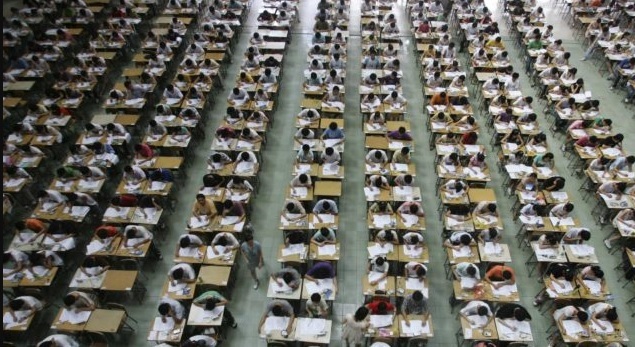
Представьте другое: все остановилось. Приостановлены строительные работы, изменено дорожное движение, на улицах дежурят патрульные машины, чтобы обеспечить тишину и порядок, и кареты скорой помощи, основные «клиенты» которых – пострадавшие от нервного срыва, на радио и телевидении только и разговоров о формате экзаменов и нынешние вопросы. Фантастика? Совсем нет. Это – ежегодная реальность в Китае. Подробнее – в адаптированном переводе материала из газеты The Guardian.
«Гаокао» или экзамен по-китайски
Подготовка к «гаокао» – государственному вступительному экзамену в высших учебных заведениях в Китае начинается еще в начальной школе. Изначально термин используется в качестве удаленного стимула для усердной учебы школьников, а позже, закаленные годами стресса и часто непомерных ожиданий, ученики осознают, насколько высоки ставки, и «крысиные гонки» набирают обороты. Хотя конкуренция – привычный признак вступления в высшие учебные заведения в любой стране, в Китае ведущие университеты могут зачислить только одного из 50 тыс абитуриентов. Выбор учебного заведения – дело ответственное, уровень безработицы среди выпускников вузов составляет около 16%, поэтому Альма-матер непосредственно влияет не только на карьеру, а даже и на брачные перспективы. Но и выбор не совсем выбор, ведь все зависит от одного единственного фактора – трехзначного результата «гаокао». Максимальное количество баллов – 750, чтобы попасть в элитные университеты столицы необходимо набрать не менее 690.
«Гаокао» – это четыре трехчасовых экзамена, которые сдаются в течение двух дней: по китайскому языку, английскому языку, математики или точных наук (биология, химия, физика), или гуманитарных наук (география, история, политология), на выбор ученика. В основном вопросы имеют форму тестов, но совсем не простых. Например, экзамен по математике сравнивают с математикой на университетском уровне в Великобритании. Но для многих выпускников самым страшным является сочинение на экзамене по китайскому языку. И дело не в размытости тем (ученики выбирают одну из двух предложенных), а в самой системе обучения. Большинство китайских учеников верят в то, что все имеет правильный ответ, но ведь сочинение – это свободное выражение мысли, которое не может быть верным или ложным.
«Гаокао» – символ китайской системы образования в целом. На западе она часто рассматривается как монолитная и механическая, а в Китае – как жесткая, но справедливая. В Европе и Америке бытует мнение, что китайские школы штампуют зомби, неспособных критически мыслить; а в Китае многие считают, что на уроках в западных школах дети прыгают на партах и рвут учебники.
История экзамена для бюрократов
Традиция единого экзамена, который решает перспективы молодого человека, достигает в Китае глубокой древности. Имперские экзамены, так называемые «кежу», во время которых испытывались претенденты на правительственные должности были введены еще во времена династии Хань (206 г. до н.э. -220 г. н.э.), и стали единственным критерием отбора с VII века. и вплоть до отмены в 1905 г. Претенденты сдавали экзамен в течение трех дней. Отбирался лишь 1% лучших среди лучших. Нервные срывы были обычным делом. В Китае даже существует призрак-божество, который ассоциируется с экзаменами: Зхонг Куи, ученый, который наложил на себя руки, когда ему было отказано в первом месте.
«Гаокао», хоть и не прямой потомок, но таки дальний родственник «кежу». Впервые введенный в 1952 г., экзамен отменили во времена культурной революции. Тогда большинство университетов закрыли, а остальные места распределялись в зависимости от политических предпочтений, а не академических способностей. А в 1977 г., через год после смерти Мао, «гаокао» восстановился в своей современной форме. На первый экзамен пришли представители поколения, лишенного шанса получить высшее образование – 5,7 млн человек, что соревновались всего за 220 тыс мест в университетах. С 1978 г. «гаокао» проводится каждое лето.
На «войне» все методы хороши
Экзамены можно пересдать через год, но если ученик продолжает терпеть неудачи, альтернативного пути в университета нет. Самоубийства – постоянный атрибут каждого экзаменационного сезона. Исследование 2014 года утверждает, что 93% случаев самоубийств в Китае произошли из-за стресса, связанного со вступительными экзаменами. И стресс из-за учебы начинается рано: в июле прошлого года 10-летний мальчик пытался покончить жизнь самоубийством, бросившись под машину, из-за ссоры с мамой по поводу домашних заданий.
В ситуации, когда или пан, или пропал, множество выпускников школ не гнушаются мошенничеством: в украшениях, кошельках, ручках, линейках и нижнем белье были найдены скрытые шпионские камеры, устройства радиосвязи и даже дужки очков, которые передают вопросы и получают ответы. В большинстве экзаменационных помещений установлены камеры видеонаблюдений, а в некоторых – и металлоискатели.
В прошлом году полиция накрыла синдикат в провинции Цзянси, где профессионалы получали от родителей до миллиона юаней (4 млн грн), чтобы сдать экзамены вместо детей. В городе Лоян в провинции Хэнань над школьными зданиями летают дроны, сканирующие отправленные и полученные радиосигналы. В некоторых школах даже сканируют отпечатки пальцев и радужную оболочку глаз учеников. Экзаменационные документы привозят в школы под бдительным присмотром охраны, а экзаменаторов, которые их составляют, тщательно контролируют, чтобы избежать утечки информации. В этом году в силу вступили новые правила: до семи лет лишения свободы за мошенничество на «гаокао».
Альтернативы и реформы гаокао
В Китае нет никаких иллюзий по поводу несовершенства системы. Вступительный экзамен повсеместно критикуют за невозможное давление на детей. Недовольство «гаокао» является одной из причин, почему богатые слои населения выбирают обучение за рубежом. Сегодня в вузах США обучается более 300 тыс китайских студентов, и еще 90 тыс. – в высших учебных заведениях Великобритании. Бедные же решают учиться не в университетах, а получить профессиональное образование, которое часто является лучшей перспективой устроиться на работу после окончания учебного заведения, особенно для тех, кто понимает, что не может набрать очень высокие баллы на вступительном экзамене.
Но, в конечном счете, большинство жителей страны поддерживает «гаокао» или, по крайней мере, не видит альтернатив. «Проблема Китая – перенаселение» – это общий рефрен, что используется для оправдания всех бед, от недостатка общественного транспорта до бедности в сельской местности. Учитывая интенсивное соревнование за образовательные ресурсы, аргумент «за» заключается в том, что должен же существовать хоть какой-то способ отделить бурьян от пшеницы и предоставить трудолюбивым ученикам из бедных семей шанс подняться на вершину.
В Китае «гаокао» иногда называют «думукиао» – трудный путь, который должен преодолеть каждый. Но равные условия не такие уж и равные. Богатые семьи тратят невероятные средства на дополнительные занятия для своих детей, что заставляет некоторых педагогов характеризовать репетиторство, как «гонку вооружений» среди домохозяйств, стремящихся повысить шансы своего ребенка на поступление в вуз. Отличается и уровень конкуренции для провинций с более высокой плотностью населения в сравнении с малонаселенными (эта лазейка привела к появлению незаконных «мигрантов» в школы провинции Внутренняя Монголия непосредственно перед экзаменом «гаокао»). Школьники в Пекине и Шанхае имеют особые привилегии, ведь лучшие университеты предлагают им щедрые квоты, несмотря на то, что эти ученики, скорее всего, является привилегированным в любом случае за возможность посещать лучшие школы.
О необходимости реформировать «гаокао» говорят со времен его появления, но результаты оставляют желать лучшего. Большая уступка имела место в начале 2000-х гг., когда отдельным провинциям позволили разработать собственные экзаменационные документы. В 2016 г. лучшие университеты объявили про собеседования с перспективными абитуриентами, предоставляя таким ученикам до 10 дополнительных баллов к результату «гаокао». В то же время относительно небольшие изменения могут встретить ожесточенное сопротивление. В мае правительство объявило, что 80 тыс университетских мест в провинциях Цзянсу и Хубэй будет зарезервирована для выпускников школ из бедных регионов с целью решения провинциальной неровности. Но толпы родителей среднего класса вышли на улицы в шести городах в знак протеста против таких реформ, опасаясь, что позитивная дискриминация в пользу более бедных семей оставит «за бортом» их собственных детей.
Когда же дело доходит до более всеобъемлющей реформы, Китая педагоги соглашаются, что любая альтернатива – возможность легкой манипуляции богатыми гражданами. Если бы вместе с экзаменационным результатом во внимание также брались обычные школьные оценки, взяточничество приняло бы еще более угрожающий масштаб (родители часто дают учителям так называемые «красные пакеты», набитые банкнотами, в обмен на особое внимание к их ребенку). То же самое касается прямого поступления в университет. Поэтому страна продолжает оценивать будущее каждого ребенка в закрытой комнате в течение двух дней в начале июня.
Интересно, что в китайском языке есть понятие «киутубейлун», так называемая «дилемма заключенных» – известный парадокс про взаимную конкуренцию, несмотря на преимущества сотрудничества: если бы каждый [ученик] согласился относиться к ситуации проще, преследовать свои собственные интересы и увлечения, конкуренция не была бы настолько сильной. Однако, они предпочитают пожертвовать своим свободным временем и тратить каждую минуту жизни на учебу, чтобы иметь больше шансов получить высокую оценку, а при таких условиях каждый должен придерживаться тех же правил.
| Gaokao | ||||||||||||||||||||||||||||
|---|---|---|---|---|---|---|---|---|---|---|---|---|---|---|---|---|---|---|---|---|---|---|---|---|---|---|---|---|
| Simplified Chinese | 普通高等学校招生全国统一考试 | |||||||||||||||||||||||||||
| Traditional Chinese | 普通高等學校招生全國統一考試 | |||||||||||||||||||||||||||
|
||||||||||||||||||||||||||||
| Higher education exam | ||||||||||||||||||||||||||||
| Chinese | 高考 | |||||||||||||||||||||||||||
|
Parents and teachers outside Beijing Bayi Middle School during the 2016 National College Entrance Examination
Results as issued in Liaoning Province in 2018
The National College Entrance Examination (NCEE), commonly known as the gaokao (高考; gāokǎo; ‘Higher Education Exam’), is a standardized college entrance exam held annually in mainland China. It is required for entrance into almost all higher education institutions at the undergraduate level, including for short cycle (2 year) and long cycle (4 year) degree programs. It is usually taken by students in their third and last year of senior high school, but the age requirement was abolished in 2001.
The exams last about nine hours over a period of two or three days, depending on the province in which it is held. The Standard Chinese language and mathematics are included in all tests. Candidates can choose one subject from English, French, Japanese, Russian, German or Spanish for the foreign language portion of the test, with most students selecting English. In most regions, students must also choose between either the liberal-arts-oriented concentration (文科倾向) or the natural-science-oriented concentration (理科倾向). Students who choose the liberal arts receive further testing in history, political science, and geography (文科综合), while those who choose natural sciences are tested in physics, chemistry, and biology (理科综合).
The overall mark received by the student is generally a weighted sum of their subject marks. The maximum possible mark varies widely from year to year and from province to province.
Generally, the modern College Entrance Examination takes place from June 7 to 8 every year, though in some provinces it can last for an extra day.[1] On rare occasions, it has been delayed, most notably due to COVID-19.[2][3]
History[edit]
A banner on the HUST campus in Wuhan congratulates top exam score achievers from the university-affiliated high school
Background[edit]
The first gaokao was held on August 15–17, 1952.[4]
The unified national tertiary entrance examination marked the start of reform of National Matriculation Tests Policies (NMTP) in the newly established People’s Republic of China. With the implementation of the first Five Year Plan in 1953, the NMTP was further enhanced. After repeated discussions and experiments, the NMTP was eventually set as a fundamental policy system in 1959. From 1958, the tertiary entrance examination system was affected by the Great Leap Forward Movement. Unified recruitment was soon replaced by separate recruitment by individual or allied tertiary education institutions. Meanwhile, political censorship on candidate students was enhanced. Since 1962, criticism of the NMTP system due to its negative impact on the working class. On July 1966, the NMTP was officially canceled and substituted with a new admission policy of recommending workers, farmers and soldiers to college.[5] During the next ten years, the Down to the Countryside Movement, initiated by Mao Zedong, forced both senior and junior secondary school graduates, the so-called «intellectual youths», to work as farmers in countryside villages. Against the backdrop of world revolution, millions of such young people joined the ranks of farmers, working and living alongside them.
In the early 1970s, Mao Zedong resumed the operation of universities. However, new students were selected through evaluation by a revolutionary committee rather than through formal academic scores. This practice continued until the death of Mao in September 1976. In late 1977, Deng Xiaoping, then under Hua Guofeng, the heir apparent of Mao, officially resumed traditional examinations based on academics, the National Higher Education Entrance Examination, which has continued to the present day.
The first such examination after the Cultural Revolution took place in late 1977. There was no limit on the age or official educational background of examinees. Consequently, most of the hopefuls who had accumulated during the ten years of the Cultural Revolution and many others who simply wanted to try their luck took the examination. The youngest were in their early teens and the oldest were in their late thirties. Exam questions were designed by individual provinces. In 1977, the total number of candidate students for the national college entrance exam was as many as 5.7 million. Although the Ministry of Education eventually expanded enrollment, adding 63,000 more to the admission quota, the admission rate of 4.8% was the lowest in the history of the PRC, with only 272,971 students being admitted.[6]
Starting from 1978, the examination was uniformly designed by the Ministry of Education and all the students across the country took identical examinations.
However, reforms on the content and structure of the exam persisted, with one of the most salient issues being agency for individual provinces to customize their own exams. The Ministry of Education allowed the College Enrollment Office of Shanghai to employ an independent exam in 1985, which was the beginning of provincial proposition. In the same year, Guangdong was permitted to adopt independent proposition. Beginning from 2003, Beijing, Tianjin, Jiangsu, and Zhejiang were allowed to adopt independent propositions. Since then, 16 provinces and municipalities have adopted customized exams.
Although today’s admission rate is much higher than in 1977, 1978 and before the 1990s, it is still fairly low compared to the availability of higher education in the Western world. Consequently, the examination is highly competitive, causing prospective examinees and their families to experience enormous pressure. For the majority of examinees, the exam is a watershed that divides two dramatically different lives.
In 1970, less than 1% of Chinese people had attended higher education, and less than 1/1000 of the population of China was admitted to universities. In the 1970s, 70% of students who were recommended to attend university had political backgrounds reflecting the political nature of university selection at the time. At the same time, the undergraduate course system reduced the time from 4 years to 3 years. According to incomplete statistics, from 1966 to 1977, institutions of higher learning recruited 940,000 people who belonged to the worker-peasant-soldier group.
For most provinces, the National Higher Education Entrance Examination is held once a year; however, some provinces hold examinations twice a year, with the additional exam referred to as the Spring Entrance Examination. Prior to 2003, the National Higher Education Entrance Examination took place in July every year. It now takes place every June. Partial Provincial administrative units determine the schedule of the exams on the 7th and 8 June. Prior to 2003, the examination was held in July, but has since been moved to the month of June. This move was made in consideration of the adverse effects of hot weather on students living in southern China and possible flooding during the rainy season in July.
2006 gaokao[edit]
In 2006, a record high of 9.5 million people applied for tertiary education entry in China. Of these, 8.8 million (93%) took the national entrance exam and 27,600 (0.28%) were exempted (保送) if the students demonstrate exceptional merit in the quality of their work and understanding of the academic subject. Everyone else (700,000 students) took other standardized entrance exams, such as those designed for adult education students.[citation needed]
2017 gaokao[edit]
In 2017, 9.40 million students took the gaokao, 7 million of whom were admitted into colleges and/or universities.[7] The percentage of first-class admission (Yi Ben (一本)), deemed as good universities in China) varied from 9.48% to 30.5%,[8] with the lowest admission rates in Henan province and Shanxi province, at less than 10%.
Below are the changes of the exam scope in 2017 (in most areas of China, where the students use the Nationwide Exam Papers in gaokao):
Chinese
- All the exam contents are set into compulsory examination scope.
Mathematics
- Elective Course 4-1 (Selection of Geometric Proof) is removed from the elective examination scope.
Foreign Language
- No changes.
Physics
- Elective Course 3-5 is changed from the elective examination scope into the compulsory examination scope.
Chemistry
- Elective Course 2 (Chemistry and Technology) is removed from the elective examination scope.
Biology
- Topic 3 (Tissue Culture Technology of Plants) is removed from the elective examination scope of Elective Course 1 (Biotechnology Practice).
Politics
- No changes.
History
- Elective Course 2 (Democratic Thought and Practice in Modern Society) is removed from the elective examination scope.
Geography
- Elective Course 5 (Natural Disasters and Prevention) is removed from the elective examination scope.
2018 gaokao[edit]
9.75 million students attended gaokao on June 7 and 8.[7]
Acceptance rate for each year[9][edit]
The number of higher education institutes in the People’s Republic of China has risen annually since 1977. From 1999 to 2020, the number of institutes increased dramatically from 1,071 to 2,740,[10] which significantly contributed to the rapid growth in the number of NCEE examinees and accepted students.
| Year | Number of examinees | Accepted students | Acceptance rate |
|---|---|---|---|
| 1977 | 5,700,000 | 270,000 | 4.74% |
| 1978 | 6,100,000 | 402,000 | 6.59% |
| 1979 | 4,680,000 | 280,000 | 5.98% |
| 1980 | 3,330,000 | 280,000 | 8.41% |
| 1981 | 2,590,000 | 280,000 | 10.81% |
| 1982 | 1,870,000 | 320,000 | 17.11% |
| 1983 | 1,670,000 | 390,000 | 23.35% |
| 1984 | 1,640,000 | 480,000 | 29.27% |
| 1985 | 1,760,000 | 620,000 | 35.23% |
| 1986 | 1,910,000 | 570,000 | 29.84% |
| 1987 | 2,280,000 | 620,000 | 27.19% |
| 1988 | 2,720,000 | 670,000 | 24.63% |
| 1989 | 2,660,000 | 600,000 | 22.56% |
| 1990 | 2,830,000 | 610,000 | 21.55% |
| 1991 | 2,960,000 | 620,000 | 20.95% |
| 1992 | 3,030,000 | 750,000 | 24.75% |
| 1993 | 2,860,000 | 980,000 | 34.27% |
| 1994 | 2,510,000 | 900,000 | 35.86% |
| 1995 | 2,530,000 | 930,000 | 36.76% |
| 1996 | 2,410,000 | 970,000 | 40.25% |
| 1997 | 2,780,000 | 1,000,000 | 35.97% |
| 1998 | 3,200,000 | 1,083,600 | 33.86% |
| 1999 | 2,880,000 | 1,596,800 | 55.44% |
| 2000 | 3,750,000 | 2,206,100 | 58.83% |
| 2001 | 4,540,000 | 2,682,800 | 59.09% |
| 2002 | 5,100,000 | 3,205,000 | 62.84% |
| 2003 | 6,130,000 | 3,821,700 | 62.34% |
| 2004 | 7,290,000 | 4,473,400 | 61.36% |
| 2005 | 8,770,000 | 5,044,600 | 57.52% |
| 2006 | 9,500,000 | 5,460,500 | 57.48% |
| 2007 | 10,100,000 | 5,659,200 | 56.03% |
| 2008 | 10,500,000 | 6,076,600 | 57.87% |
| 2009 | 10,200,000 | 6,394,900 | 62.70% |
| 2010 | 9,460,000 | 6,617,600 | 69.95% |
| 2011 | 9,330,000 | 6,815,000 | 73.04% |
| 2012 | 9,150,000 | 6,888,300 | 75.28% |
| 2013 | 9,120,000 | 6,998,300 | 76.74% |
| 2014 | 9,390,000 | 7,214,000 | 76.83% |
| 2015 | 9,420,000 | 7,378,500 | 78.33% |
| 2016 | 9,400,000 | 7,486,100 | 79.64% |
| 2017 | 9,400,000 | 7,614,900 | 81.01% |
| 2018 | 9,750,000 | 7,909,900 | 81.13% |
| 2019 | 10,310,000 | 9,149,000 | 88.74% |
| 2020 | 10,710,000 | 9,675,000 | 90.34% |
| 2021 | 10,780,000 | 10,013,200 | 92.89% |
| 2022 | 11,930,000 |
| Province | Chinese | 2022 | 2021 | 2020 | 2019 | 2018 | 2017 | 2016 | 2015 | 2014 | 2013 | 2012 | 2011 | 2010 | 2009 | 2008 | 2007 | 2006 | 2005 | 2004 | 2003 | 2002 | 2001 | 2000 | 1999 |
|---|---|---|---|---|---|---|---|---|---|---|---|---|---|---|---|---|---|---|---|---|---|---|---|---|---|
| Beijing | 北京 | 54,728 | 51,738 | 49,225 | 59,209 | 63,073 | 60,638 | 61,222 | 68,000 | 70,500 | 72,736 | 73,000 | 76,000 | 81,000 | 101,000 | 103,700 | 109,876 | 110,300 | 98,745 | 85,000 | 81,266 | 70,000 | 64,479 | 56,000 | — |
| Tianjin | 天津 | 58,000 | 56,000 | 56,300 | 56,000 | 55,074 | 57,015 | 60,000 | 61,990 | 60,000 | 63,000 | 64,000 | 64,600 | 71,000 | 76,500 | 88,500 | 88,500 | 83,600 | 73,836 | 67,000 | 59,000 | 57,797 | 52,312 | — | — |
| Hebei | 河北 | 753,200 | 634,000 | 624,800 | 559,600 | 486,400 | 436,200 | 423,100 | 404,800 | 418,200 | 449,800 | 459,300 | 485,000 | 503,000 | 559,000 | 574,800 | 561,800 | 557,600 | 483,000 | 389,535 | 337,000 | 302,000 | — | — | — |
| Shanxi | 山西 | 337,000 | 315,700 | 326,000 | 314,000 | 305,071 | 317,000 | 339,131 | 342,278 | 341,600 | 358,000 | 361,000 | 339,000 | 362,000 | 360,000 | 370,000 | 331,000 | 320,000 | 297,288 | 247,858 | 210,114 | 171,717 | — | — | — |
| Inner Mongolia | 内蒙 | 185,000 | 198,000 | 197,900 | 199,000 | 195,000 | 198,697 | 201,131 | 189,500 | 188,000 | 193,267 | 189,500 | 205,600 | 219,000 | 246,000 | 270,000 | 239,000 | 200,000 | 200,000 | 186,743 | 166,457 | 137,129 | — | — | — |
| Liaoning | 辽宁 | 245,259 | 218,000 | 225,000 | 244,000 | 185,000 | 208,502 | 218,252 | 225,191 | 239,000 | 254,000 | 256,000 | 245,000 | 243,500 | 280,000 | 300,000 | 290,000 | 270,000 | 247,000 | 205,123 | 176,000 | 186,480 | 160,000 | — | — |
| Jilin | 吉林 | 169,400 | 160,000 | 142,000 | 162,787 | 150,239 | 142,900 | 148,000 | 137,681 | 160,200 | 159,000 | 162,000 | 165,000 | 169,000 | 197,000 | 208,000 | 201,000 | 172,000 | 160,000 | 124,796 | 118,866 | 109,224 | — | — | — |
| Heilongjiang | 黑龙江 | 204,000 | 210,000 | 211,000 | 204,000 | 190,424 | 188,000 | 197,000 | 198,000 | 204,000 | 208,000 | 210,000 | 208,000 | 195,000 | 230,000 | 228,000 | 224,000 | 219,200 | 201,130 | 173,100 | 159,800 | 150,400 | 120,000 | — | — |
| Shanghai | 上海 | 50,000 | 50,000 | 50,000 | 50,000 | 50,000 | 51,000 | 51,000 | 51,000 | 52,000 | 53,000 | 55,000 | 61,000 | 67,000 | 83,000 | 108,000 | 110,452 | 113,800 | 112,000 | 110,000 | 91,922 | 93,900 | 91,200 | — | — |
| Jiangsu | 江苏 | 406,000 | 359,000 | 348,900 | 339,000 | 331,500 | 330,100 | 360,400 | 392,900 | 425,700 | 451,000 | 475,000 | 500,000 | 527,000 | 546,000 | 508,000 | 530,000 | 495,000 | 480,000 | 405,000 | 341,410 | 289,400 | 290,731 | 230,000 | 210,000 |
| Zhejiang | 浙江 | 365,000 | 332,400 | 325,700 | 325,100 | 306,000 | 291,300 | 307,400 | 280,000 | 308,600 | 313,000 | 315,800 | 299,000 | 300,800 | 348,500 | 364,400 | 358,800 | 352,000 | 313,000 | 250,000 | 229,000 | 205,900 | 179,000 | — | — |
| Anhui | 安徽 | 601,000 | 542,500 | 523,800 | 513,000 | 499,000 | 498,600 | 509,900 | 546,000 | 527,000 | 511,000 | 506,000 | 540,000 | 562,000 | 572,000 | 610,000 | 564,000 | 463,500 | 417,000 | 346,885 | 292,106 | 242,530 | 200,000 | — | — |
| Fujian | 福建 | 218,000 | 201,000 | 202,600 | 207,800 | 200,927 | 188,200 | 175,000 | 189,300 | 255,000 | 255,000 | 250,000 | 267,000 | 292,000 | 305,000 | 312,000 | 309,300 | 250,000 | 256,800 | 220,000 | 204,588 | 167,264 | — | — | — |
| Jiangxi | 江西 | 574,800 | 493,000 | 462,000 | 421,300 | 380,000 | 364,900 | 360,600 | 354,641 | 325,000 | 274,300 | 269,000 | 288,600 | 312,000 | 350,000 | 384,400 | 384,292 | 350,000 | 316,667 | 278,298 | 205,389 | 165,951 | 150,885 | — | — |
| Shandong | 山东 | 598,810 | 555,102 | 530,381 | 601,000 | 592,000 | 583,000 | 602,000 | 696,198 | 558,000 | 500,000 | 550,000 | 587,000 | 660,000 | 700,000 | 800,000 | 777,541 | 800,000 | 731,166 | 566,657 | 529,737 | 451,105 | — | — | — |
| Henan | 河南 | 1,250,000 | 1,046,000 | 1,158,000 | 1,084,000 | 983,800 | 865,800 | 820,000 | 772,000 | 724,000 | 716,300 | 805,000 | 855,000 | 952,400 | 959,000 | 905,000 | 878,847 | 780,000 | 719,970 | 595,537 | 498,000 | 354,000 | 291,000 | — | — |
| Hubei | 湖北 | 460,000 | 405,000 | 394,800 | 384,000 | 374,302 | 362,000 | 361,478 | 368,425 | 402,700 | 438,000 | 457,000 | 484,700 | 490,000 | 519,500 | 525,000 | 503,300 | 533,000 | 458,679 | 372,000 | 330,000 | 288,000 | 228,842 | — | — |
| Hunan | 湖南 | 655,000 | 574,900 | 537,000 | 499,000 | 451,800 | 410,800 | 401,600 | 390,000 | 378,000 | 373,000 | 352,000 | 372,000 | 413,000 | 507,000 | 540,000 | 518,782 | 480,000 | 425,000 | 349,000 | 299,104 | 258,100 | 218,100 | — | — |
| Guangdong | 广东 | 859,000 | 783,000 | 779,600 | 768,000 | 758,000 | 730,000 | 733,000 | 754,000 | 756,000 | 727,000 | 692,000 | 655,000 | 615,000 | 644,000 | 614,000 | 553,826 | 517,400 | 451,400 | 389,400 | 335,000 | 260,000 | 241,026 | 185,521 | — |
| Guangxi | 广西 | 610,000 | 550,400 | 507,000 | 470,000 | 400,000 | 365,000 | 330,000 | 310,000 | 315,000 | 298,000 | 285,000 | 292,000 | 299,000 | 302,000 | 304,000 | 300,000 | 274,900 | 255,232 | 216,675 | 185,465 | 156,141 | 128,365 | — | — |
| Hainan | 海南 | 63,874 | 59,848 | 57,000 | 60,148 | 58,775 | 57,000 | 60,403 | 62,000 | 61,000 | 56,662 | 55,000 | 54,000 | 54,700 | 57,800 | 49,800 | 42,300 | 41,000 | 45,000 | 34,400 | — | 26,265 | 19,596 | — | — |
| Chongqing | 重庆 | 314,000 | 289,500 | 283,000 | 264,000 | 250,473 | 247,500 | 248,888 | 255,460 | 250,600 | 235,000 | 230,000 | 216,400 | 196,700 | 196,000 | 186,000 | 177,349 | 190,000 | 160,000 | 130,000 | 95,329 | 81,917 | 62,665 | — | — |
| Sichuan | 四川 | 770,000 | 698,000 | 674,700 | 654,200 | 620,000 | 582,800 | 571,400 | 575,700 | 571,700 | 540,000 | 538,000 | 514,000 | 511,500 | 500,000 | 517,600 | 498,800 | 453,300 | 450,000 | 339,000 | 258,798 | 227,500 | 193,351 | — | — |
| Guizhou | 贵州 | 478,000 | 466,736 | 470,000 | 458,700 | 441,731 | 411,897 | 373,873 | 330,591 | 292,700 | 247,800 | 248,000 | 243,100 | 234,000 | 240,000 | 240,000 | 225,700 | 194,000 | 168,502 | 131,982 | 109,122 | 76,776 | 68,700 | — | — |
| Yunnan | 云南 | 388,300 | 358,000 | 343,200 | 326,100 | 300,296 | 293,500 | 281,071 | 272,126 | 255,900 | 236,000 | 210,000 | 230,000 | 220,000 | 220,000 | 260,000 | 200,000 | 181,400 | 171,824 | 123,321 | 119,956 | 101,358 | — | — | — |
| Tibet | 西藏 | 32,000 | 26,000 | 32,973 | 27,580 | 25,343 | 28,500 | 23,976 | 22,590 | 19,625 | 18,949 | 19,000 | 18,000 | 18,000 | 13,600 | 15,000 | 15,000 | 13,700 | 14,000 | 12,157 | 9,500 | 6,510 | — | — | — |
| Shaanxi | 陕西 | 323,058 | 312,919 | 322,344 | 325,911 | 319,000 | 319,196 | 328,000 | 344,000 | 353,000 | 366,498 | 375,300 | 383,900 | 378,500 | 405,000 | 414,000 | 411,700 | 373,200 | — | 295,941 | 244,707 | 189,250 | 149,200 | — | — |
| Gansu | 甘肃 | 243,248 | 245,917 | 263,100 | 266,800 | 273,000 | 284,758 | 296,925 | 303,838 | 297,000 | 283,000 | 296,000 | 297,000 | 291,000 | 286,000 | 290,000 | 272,000 | 248,000 | — | 162,000 | 136,000 | 115,000 | — | — | — |
| Qinghai | 青海 | 48,400 | 44,000 | 56,700 | 55,114 | 42,000 | 46,346 | 44,600 | 42,682 | 39,700 | 40,600 | 38,000 | 40,600 | 38,000 | 39,000 | 41,000 | 38,000 | 40,000 | 33,000 | — | — | — | — | — | — |
| Ningxia | 宁夏 | 65,694 | 62,467 | 60,300 | 71,702 | 69,475 | 69,233 | 69,119 | 67,708 | 64,000 | 58,700 | 60,200 | 60,100 | 57,000 | 58,000 | 58,000 | 56,500 | 50,000 | — | — | 41,244 | 30,388 | 30,166 | — | — |
| Xinjiang | 新疆 | 218,500 | 209,800 | 229,300 | 220,900 | 207,400 | 183,700 | 166,100 | 160,500 | 162,600 | 158,700 | 154,700 | 147,700 | 164,200 | 164,500 | 170,000 | 154,096 | 128,100 | 130,000 | 100,000 | 91,000 | 79,300 | 67,000 | 66,810 | — |
Subjects before NCEE Reform[edit]
The subjects tested in the National Higher Education Entrance Examination have changed over time. Traditionally, students would undertake either a set of «liberal-art» subjects or a set of «science» subjects, with some shared compulsory subjects which were Chinese, mathematics and a foreign language. The subjects taken in the Examination affected the degree Examination, or implemented flexible systems for selecting the subjects to be tested, resulting in a number of different systems. But things are changing. A reform was announced in and begun from 2014 and will be completed by 2025.
«3+X» system[edit]
As a pilot examination system used in order to promote education system reform, this examination system has been implemented in most parts of the country, including Beijing City, Tianjin City, Hebei Province, Liaoning Province, Jilin Province, Heilongjiang Province, Anhui Province, Fujian Province, Guangdong Province, Jiangxi Province, Henan Province, Shandong Province, Hubei Province, Shaanxi Province, Sichuan Province, Guizhou Province, Yunnan Province, Shanxi Province, Chongqing City, Gansu Province, Qinghai Province, Inner Mongolia, Guangxi, Ningxia, Xinjiang and Tibet. In the context of the reform of the National College Entrance Examination, this program will be suspended in Beijing, Tianjin, Shandong and Hainan provinces from 2020, and will be suspended in most provinces and cities in China from 2021. It will cease across Mainland China by 2022.
- «3» refers to compulsory subjects, including «Chinese, Mathematics and a foreign language», each of which accounts for 150/750 in total score.
- «X» means that students can choose, according to their own capability, one subject from either Social Sciences (including Political Sciences, History and Geography), or Natural Sciences (including Physics, Chemistry and Biology), which accounts for 300/750 in total score.
- If a student chooses Natural Sciences, then he or she will take a relatively harder mathematics test as well, including Curves and Equations, Space Vector and Solid Geometry, The Concept of Definite Integral, Fundamental Theorem of Calculus, Simple Application of Definite Integral, Mathematical Induction, Counting Principle, Random Variable and Its Distribution.
- For candidates of minor ethnic groups in Tibet, Xinjiang, Inner Mongolia, Qinghai and Jilin, their Literature score consists of an easier Chinese Literature test and an optional subject on Tibetan, Mongolian, Uyghur and Korean Literature, each counting for 75 points.
| Compulsory Subjects | Score | Time | Elective Subjects | Score | Time | |
|---|---|---|---|---|---|---|
| Social Sciences | Chinese, Mathematics (for arts students) and a foreign language | 450/750, 150 each | 150 minutes for Chinese (9:00 to 11:30 on June 7), 120 minutes for Mathematics (15:00 to 17:00 on June 7) and the foreign language (15:00 to 17:00 on June 
|
Political Sciences, History and Geography | 300/750, 100+100+100 | 150 minutes (9:00 to 11:30 on June 
|
| Natural Sciences | Chinese, Mathematics and a foreign language | 450/750, 150 each | 150 minutes for Chinese (9:00 to 11:30 on June 7), 120 minutes for Mathematics (15:00 to 17:00 on June 7) and the foreign language (15:00 to 17:00 on June 
|
Physics, Chemistry and Biology | 300/750, 110+100+90 | 150 minutes (9:00 to 11:30 on June 
|
Region specific[edit]
«3+X+Y» system[edit]
The system was used in Zhejiang Province, with the last exam offered in 2016 to «Class-of-2013» (Chinese: 2013级, meaning admitted to senior high school in 2013, i.e., being Grade 10 in 2013) while «Class-of-2014» students have been taking the reformed version of Gaokao since 2017.
The «3» and «X» are the same as the national «3+X» system, weighed 750 points. The «Y» part consists of 18 problems, covering 9 subjects (Chinese, Maths, English, Physics, Chemistry, Biology, History, Politics, and Geography), from which students need to choose 6 problems to answer, weighed 60 points. The total score is 810 points.
«3+2» system[edit]
This system used to be employed in Jiangsu Province, but is being replaced by another system in 2020. The total score was 480 points.
- «3» refers to three compulsory subjects «Chinese, mathematics and a foreign language», which are recorded in the total score.
- «2» refers to selecting two subjects either from Politics, History or Geography for arts students, or from Biology, Chemistry or Physics for science students, which are not recorded in total score but a class like A, B, etc. will be recorded.
- Bonus Points: refers to 4 comprehensive science or liberal arts exams, one gets a bonus of 5 points if they get 4 «A»s in all 4 elective exams.
«4+X» system[edit]
This system was used after the New Curriculum Reform being employed in Guangdong province, and now it has been abandoned.
- «X» means that according to their own interests, candidates can choose one or two subjects either from arts subjects, including Politics, History and Geography (Politics and Geography cannot be chosen simultaneously), or from science subjects, including Biology, Physics and Chemistry (Physics and Biology cannot be chosen simultaneously).
- Chinese and a foreign language are compulsory. Two separate Mathematics tests are designed respectively for arts students and science students.
- In addition to three compulsory subjects and X subject, arts students have to take comprehensive tests of arts, and science students have to take comprehensive tests of science.
«3+1+X» system[edit]
This system has been implemented in Shanghai since the employment of comprehensive courses, now abandoned.
- «3» refers to three compulsory subjects «Chinese, Mathematics and a foreign language», with 150 scores for each subject.
- «1» refers to one subject that candidates choose according to their own interests and specialty from «Politics, History, Geography, Physics, Chemistry and Biology». This subject accounts 150 scores when admitted by universities and colleges at undergraduate level. The score is not included in the total score when admitted by vocational and technical colleges. Therefore, candidates can give up this subject when applying for colleges at vocational and technical level.
- «X» refers to comprehensive ability test, which is categorized into arts tests and science tests. Arts students can either choose one subject from Politics, History and Geography, or take an arts comprehensive test when giving up «1′ subject. Science students can either choose one subject from Physics, Chemistry and Biology, or take a science comprehensive test when giving up «1» subject. Regardless of arts and science categories, all the comprehensive ability tests cover knowledge of six subjects,including Politics, History, Geography, Physics, Chemistry and Biology. In the first volume of the arts test, number of questions related to arts subjects exceeds science questions, and vice versa; the second volume of the two tests are the same.
«3+2+X» system[edit]
This is a pilot college entrance examination system implemented by the Jiangsu Province in 2003 after examining other testing systems, but it was replaced by «3+2» system in 2008. Subject tests will take turns into the embrace of National Standard. A new policy substituted the old one in 2021.
- «3» refers to three compulsory subjects «Chinese, mathematics and a foreign language», which are recorded in the total score.
- «2» refers to choosing two subjects from the following six areas «politics, history, geography, physics, chemistry, biology», which are not recorded in total score but a class like A+, A, etc. will be recorded.
- «X» refers to a comprehensive science or liberal arts exam, which is not recorded in the total score, only for university admission reference.
«3+X+1» system[edit]
This is part of the curriculum reform in China.
- «3» refers to Chinese, Mathematics and a foreign language, which are compulsory testing subjects for each candidate.
- «X» means choosing one of the two comprehensive tests in either sciences or liberal arts, according to the student’s interest. The «3» and «X» are the same as the national «3+X» system.
- «1» refers to a basic proficiency test on skills (基本能力测试) that high school graduates needs and should have in order to adapt to social life. This college entrance examination system was implemented for the first time in Shandong in 2007 and ended in 2014.[11]
- The examination system in Shandong Province reverted to the «3+X» system as of the most recent testing in June 2014 and took the reform plan from 2020.
Reform of the National College Entrance Examination[edit]
For a summary of information about this program, see the topic page of Sina Education.[12]
«3+1+2» system[edit]
This system was first introduced in 2019, when Hebei Province, Liaoning Province, Jiangsu Province, Fujian Province, Hubei Province, Hunan Province, Guangdong Province, Chongqing City announced their examination reform plan, and performed on the 2018 students. This system gives students a wider choice on what subjects they are being tested on comparing to «3+X» system, but limits students’ choice against the «3+3» system. By 2024, most regions of the country would implement the system as the successor of their «3+X» system.
- «3» refers to compulsory subjects, including «Chinese, Mathematics and a foreign language», each of which accounts for 150/750 in total score.
- «1» refers to a selection between Physics and History, which accounts 100/750 in total score.
- «2» refers to two subjects that candidates choose according to their own interests and specialty from Chemistry, Biology, Politics and Geography. This test was renamed as Grading Exam of the Academic Proficiency Examination for Senior High School Students (普通高中学业水平等级性考试) as these exams are held per region, unlike the compulsory courses which are held nationally by the Ministry of Education.
To promise the legitimacy of the Grading Exam courses, the final scores of the four courses were transferred to band scores before they were counted into the total score. Example below is Guangdong’s algorithm.[13]
When weighing the score, the candidate’s score of one course are sorted from high to low, and divided into five group according to rank distribution. A grade from A to E was given to these groups. The band score is then calculated after confirming the grade.
| Grade | A | B | C | D | E |
| Approx. Portion | ~17% | ~33% | ~33% | ~15% | ~2% |
| Band Score Range | 100-83 | 82-71 | 70-59 | 58-41 | 40-30 |
The band score has a range from 100 to 30, each grade has a typical range of 10pts to 17pts. According to each candidate’s actual score, the score’s belonging grade, and the grade’s scoring range, the score was transferred in proportion by the following formula:






«3+3» system[edit]
This system has been implemented in Shanghai and Zhejiang since the employment of comprehensive courses since September 2014. Since 2017, Beijing, Tianjin, Shandong, Hainan have begun to use this program.
- The first «3» stands for three compulsory courses, including Chinese, mathematics, and a foreign language (a choice of one from English, Japanese, Russian, German, French, Spanish).
- The second «3» stands for three selective courses which depends on students’ choice from physics, chemistry, biology, technology (Zhejiang only), geography, politics and history. Like above, this test was renamed as Grading Exam of the Academic Proficiency Examination for Senior High School Students (普通高中学业水平等级性考试).
- Originally, the initial intention of the reform was to let students develop their strengths and avoid their weaknesses; however, students taking the exam rushed to test into subjects that were perceived as higher-scoring. This has resulted in very few people entering into certain subjects, such as physics.
- In the calculation of the scores of the other, 70 points (in Shanghai) or 100 points (in Zhejiang) for each of the subjects, according to the levels like A+, A, B+, …, D, E, etc (Divided into 21 grades in Zhejiang, 11 in Shanghai; 3 points between every two grades). According to the published news, Beijing and Tianjin indicated that their plan is similar to the Zhejiang plan, and Anhui’s request for comment is similar to Zhejiang, too;[14] Shandong is divided into eight grades of A, B+, B, C+, C, D+, D, and E. According to the original scores and equal conversion rules of the candidates, they are converted to 91-100, 81-90, 71-80, 61-70, 51-60, 41-50, 31-40, 21-30 eight score intervals, get the grades of candidates.[15][16]‘
- Another concern is that candidates who want to take the college entrance examination must first take the Qualifying Exam of the Academic Proficiency Examination for Senior High School Students (普通高中学业水平合格性考试), which results are credited as «qualified» and «failed».
| Subject | Compulsory Courses | Elective Compulsory Courses |
|---|---|---|
| Chinese | Compulsory First Volume Compulsory Last Volume |
Elective Compulsory First Volume Elective Compulsory Middle Volume Elective Compulsory Last Volume |
| mathematics | Compulsory First Volume Compulsory Second Volume |
Elective Compulsory First Volume Elective Compulsory Second Volume Elective Compulsory Third Volume |
| English | Compulsory First Volume Compulsory Second Volume Compulsory Third Volume |
Elective Compulsory First Volume Elective Compulsory Second Volume Elective Compulsory Third Volume Elective Compulsory Fourth Volume |
| physics | Compulsory First Volume Compulsory Second Volume Compulsory Third Volume |
Elective Compulsory First Volume Elective Compulsory Second Volume Elective Compulsory Third Volume |
| chemistry | Compulsory First Volume Compulsory Second Volume |
Elective Compulsory I Principle of Chemical Reaction Elective Compulsory II Material Structure and Properties Elective Compulsory III Fundamentals of Organic Chemistry |
| biology | Compulsory I Molecules and Cells Compulsory II Heredity and Evolution |
Elective Compulsory I Steady State and Regulations Elective Compulsory II Creatures and Environment Elective Compulsory III Biotechnology and Biological Engineering |
| politics | Compulsory I Socialism with Chinese Characteristics Compulsory II Economy and Society Compulsory III Politics and Rule of Law Compulsory IV Philosophy and Cultures |
Elective Compulsory I Contemporary International Politics and Economy Elective Compulsory II Law and Life Elective Compulsory III Logic and Thinking |
| history | Compulsory Outline of Chinese and Foreign History (I) Compulsory Outline of Chinese and Foreign History (II) |
Elective Compulsory I National System and Social Governance Elective Compulsory II Economic and Social Life Elective Compulsory III Cultural Exchange and Communication |
| geography | Compulsory First Volume Compulsory Second Volume |
Elective Compulsory I Fundamentals of Physical Geography Elective Compulsory II Regional Development Elective Compulsory III Resources, Environment and National Security |
Procedure[edit]
The National Higher Education Entrance Examination is not uniform across the country, but administered uniformly within each province of China or each direct-controlled municipality. The National Higher Education Entrance Examination is graded variously across the country.
Before the examination[edit]
In the winter of the year before the examination year, students are required to register for the examination. The registration is usually completed on the official website of the provincal academy of educational recruitment and examination, and examinees are required to fill out an online form, which includes name, gender, date of birth, identification number, address, domicile, political status, school, phone number, and other informations about the examination and admission. The form requires students to choose elective-mandatory subjects they elected. Three subjects are universally mandatory: Chinese, Mathematics, and a foreign language — usually English, but this may be substituted by Russian, Japanese, German, French or Spanish, less than 1% students substitute by other languages. The other six standard subjects are three natural-science subjects — physics, chemistry, biology, and three liberal-art subjects — history, geography, and political science;[17] applicants can elect 3 subjects to take tests from them. Six subjects students take test in Gaokao consist of three universally mandatory subjects and three elective-mandatory subjects which was chosen by applicants.
However, there are general requirements examinees have to comply with:
- Abide by the Constitution and laws of the People’s Republic of China.
- Have a high school diploma or equivalent.
- Be in good health.
- Have read carefully and are willing to abide by the rules of the Register and other regulations and policies of the Institutions of Higher Learning and the Office of Admissions Committee about the enrollment management.
- If foreign immigrants who settle down in China conform to the enlists condition of the National Higher Education Entrance Examination, they can then apply for the National Higher Education Entrance Examination with the foreign immigrants’ resident certificate, which are sent by the Provincial Public Security Department at the location that is assigned.
- If willing to apply for the Military Academy: students who are graduating this year and have studied in high school for the first time cannot be older than 20 years of age and unmarried; if willing to apply for the Police Academy: students who are graduating this year and have studied in high school for the first time cannot be older than 22 years of age and unmarried; if willing to apply for the foreign language major in Police Academy: students who are graduating this year and have studied in high school for the first time cannot be older than 20 years of age and unmarried.
- If students from Juvenile Classes want to take the National Higher Education Entrance Examination, their schools need to pre-select, send a certification of approval, inform the exact required courses, and clarify the offices of Admissions Committee where they will take the National Higher Education Entrance Examination. After doing so, the students can then file the application. After the Office of Admissions Committee reviews and approves, the students can apply for and attend the National Higher Education Entrance Examination at the correct location. Students who apply for Shao Nian Ban must be part of a small percentage of the population. They must have very high IQ, their grades must be excellent, and they must study at a secondary or high school under the age of 15 (excluding those who are graduating this year and have studied in high school for the first time).
The following groups are prohibited from taking the exam:
- Students who are currently studying in higher education.
- Students whose files are incomplete, such as those with no school status.
- One who is serving a prison sentence or is being prosecuted for violating Criminal Law of the People’s Republic of China.
In the spring before Gaokao, examinees participate in school-organized medical examinations, in order to find diseases affect future majors. For example, students with myopia are not allowed to apply for military schools, and colorblind students won’t be admitted by medical professions. It is also noting that «have a high school diploma or equivalent» requires students to firstly take Qualifying Examination of the Academic Proficiency Examination for Senior High School Students (普通高中学业水平合格性考试), unofficially called «Huikao (会考)», including 12 subjects students learned in senior high school. The examination are always very simple to pass. Their results are credited as «qualified» and «failed», «qualified» accounts for 97% of the total number of examination and «failed» accounts 3% of the total, in the end hand in a Comprehensive Qualification Report based on the student’s performance and social activity. The result of the Qualifying Examination and the Report would be given to the college as a reference when admitting. Failed students have three chances to take makeup examinations. Chemistry, biology, geography and history examinations are held in the summer of senior one; Chinese, mathematics, English, physics, politics examinations took places in the winter of senior two; and information technology and general technology examinations took up in the summer of senior two; physical education test is in the spring of senior three-months before Gaokao. Elective subjects they failed in Huikao are not available for applicants when signing upto Gaokao.
Examination[edit]
It is arranged at the end of the spring semester and secondary school graduates across the country take the examination simultaneously over a two to four-day period.
| 日期 | 7 Jun. | 8 Jun. | 9 Jun. | 10 Jun. | |||||
|---|---|---|---|---|---|---|---|---|---|
| Time | 9:00-11:30 | 15:00-17:00 | 15:00-16:40 | 8:00-9:30 | 11:00-12:30 | 15:30-17:00 | 8:00-9:30 | 11:00-12:30 | 15:30-17:00 |
| Subject | Chinese | mathematics | foreign language | physics | politics | chemistry | history | biology | geography |
| Score | 150 | 150 | 150 | 100 | 100 | 100 | 100 | 100 | 100 |
Admission[edit]
Applicants to some specialist programs are also screened by additional criteria: some art departments (e.g. audition), military and police schools (political screening and physical exam), and some sports programs (tryout).
Exam scores can be used to apply to universities outside mainland China. Across the globe, Hong Kong is on their top list. In 2007, 7 students with the overall highest score in their provinces entered Hong Kong’s universities rather than the two major universities in mainland China. In 2010, over 1,200 students entered the 12 local institutions which provide tertiary education courses through this examination. In addition, City University of Hong Kong and Chinese University of Hong Kong directly participate in the application procedure like other mainland universities.
The examination is essentially the only criterion for tertiary education admissions. Poor test performance almost always means giving up on that goal. Students hoping to attend university will spend most of their waking moments studying prior to the exam. If they fail in their first attempt, some students repeat the last year of high school to retake the exam during the following year.
In different places and across different time periods in history, students were required to apply for their intended university or college prior to the exam, after the exam, or more recently, after they receive their scores, by filling a list of ranked preferences. The application list is classified into several tiers (including at least early admissions, key universities, regular universities, vocational colleges), each of which can contain around 4-6 choices for institutions and programs. Typically, an institution or program would only admit students who apply to it as their first choice in each tier. In some regions, students are allowed to apply for different tiers at different times. For example, in Shanghai, students apply for early admission, key universities and regular universities prior to the exam, but can apply for other colleges after they receive their scores.
Criticisms[edit]
Regional discrimination[edit]
A university usually sets a fixed admission quota for each province, with a higher number of students coming from its home province. As the advanced educational resources (number and quality of universities) are distributed unevenly across China, it is argued that people are being discriminated against during the admission process based on their geographic region. For example, compared to Beijing, Jiangxi province has fewer universities per capita. Therefore, Jiangxi usually receives fewer admission quotas compared with Beijing, which makes a significantly higher position among applicants necessary for a Jiangxi candidate to be admitted by the same university than their Beijing counterpart. The unequal admission schemes for different provinces and regions might intensify competition among examinees from provinces with fewer advanced education resources. For example, Peking University planned to admit 800 science students from Beijing (with 80,000 candidates in total), but only 38 from Shandong (with 660,000 candidates in total). This is not similar to the practice of regional universities in other countries which receive subsidies from regional governments in addition to or in place of those received from central governments, as universities in China largely depend on state budget rather than local budget. However, this regionally preferential policy does provide subsidies to minority students from under-developed regions that enjoy limited educational resources, such as Tibet and Xinjiang.
The regional discrimination can be proved by the disparities between ratios of a province’s enrollment of students to the total number of candidate students of the province. In 2010, the acceptance rates for students from Beijing, Shanghai, Shandong and Henan who applied for universities of the first-ranking category were 20.1%, 18%, 7.1% and 3.5% respectively. High acceptance rates are likely to appear in the most and least developed cities and provinces, such as Beijing, Shanghai or Qinghai. In contrast, acceptance rates remain relatively equal among provinces of the average developmental level.
In recent years, varied admission standards have led some families to relocate for the sole purpose of advancing their children’s chances of entering university.[18]
In addition, regional discrimination is not only restricted to the ratio for admission. This is best illustrated with an example of the Hubei Province, where students’ exam scores have been higher than other provinces for a long time. A score for a Hubei student to just reach the admission cut-off line for a key university may be enough for a student from another province to be admitted by a much better university, and even enough for a Beijing student to be admitted by top universities like Tsinghua University and Peking University.
Some local students in Hong Kong complained that it was unfair that the increasing intake of Mainland students who have performed at a high level in this examination increases the admission grades of universities, making it harder for local students to get admission. In 2010, more than 5,000 out of the 17,000 students who achieved the minimum university entry requirement were not offered places in any degree courses in the UGC-funded universities.
Migrant children[edit]
As a student is required to take exams in the region where their household registration (under the Hukou system) is located, the qualification of migrant children becomes controversial.[19] Since 2012, some regions began to relax the requirements and allow some children of migrants to take their College Entrance Exam in regions outside of their household registration. As of 2016, Guangdong’s policies are the most relaxed. A child of migrants can take their Entrance Exam in Guangdong if they have attended 3 years of highschool in the province, and if the parent(s) have legal jobs and have paid for 3 years of social insurance in the province.[20]
Special concessions[edit]
There are special concessions for members of ethnic minorities, foreign nationals, persons with family origin in Taiwan, and children of military casualties. Students can also receive bonus marks by achieving high results in academic Olympiads, other science and technology competitions, sporting competitions, as well as «political or moral» distinction. In the 2018 National People’s Congress, the government passed legislation abolishing all bonus scores from competitions.
Psychological pressure[edit]
Because gaokao is one of the most influential examinations in China and students can only take the test once a year, both teachers and students undergo tremendous pressure in preparing for and taking the exam. For teachers, because the society heavily focuses on the rate of admission into universities, they have to work harder to prepare every student for the exam. Because of this, teachers give students more and more practice for exams. This teaching methodology, colloquially referred to as «cramming», involves students memorizing large volumes of information fed to them by teachers and undertaking many practice exercises in order to optimize exam writing ability. One of the disadvantages of this method is the lack of focus on teaching critical thinking and ignoring students’ emotions, values and personalities. Many examinees suffer from severe anxiety during the test. In some cases, examinees may faint in the examination room.[21]
Further and deeper stemming criticisms have been leveled that the testing system is the «most pressure packed examination in the world».[22] Behaviors surrounding the testing period have been extreme under some reports, with doctors in Tianjin purportedly prescribing birth control pills to female students whose parents wanted to ensure the girls were not menstruating at the time of examination.[22] Testing pressure, for some critics, has been linked to faintings, increased drop out rates, and even increasing rates of teenage clinical depression.
Pressure caused as a result of the gaokao has been linked to a rise in student suicides.[23] A school in Hebei province installed suicide barriers to prevent students from jumping to their deaths in response to two suicides in the facility related to the exam.[24]
Impact[edit]
The gaokao tends to impact the lives of most Chinese teenagers and their parents. In Zhengzhou, Henan, the local bus company parked a 985 number bus outside a gaokao center for parents to wait in, the number reflects a popular enrollment program number for university entrances.[1]
See also[edit]
- Education in China
- Hong Kong Diploma of Secondary Education
- Higher education in China
- List of admission tests to colleges and universities
- List of universities in China
- JEE-Main
- Suneung
References[edit]
- ^ a b Chi, ma (8 June 2017). «Scenes from the most important test in China». China Daily. Retrieved 9 June 2017.
- ^ Liu, John (2022-06-07). «China Tries to Keep Covid Out of Its Grueling College Entrance Exams». The New York Times. ISSN 0362-4331. Retrieved 2022-06-08.
- ^ «关于2020年全国高考时间安排的公告 — 中华人民共和国教育部政府门户网站». Archived from the original on 2020-06-30. Retrieved 2022-06-08.
- ^ «Lishi de jintian: 1952 nian 8 yue 15 ri juxing shouci quanguo tongyi gaokao» 历史的今天:1952年8月15日举行首次全国统一高考 [History today: The first national unified gaokao on August 15, 1952]. Zhongguo jiaoyu wang (in Chinese). Archived from the original on June 9, 2021. Retrieved June 27, 2021.
- ^ Guodong Wei, «On the Reform of China’s NCEE since 1977» (PhD diss., Hebei University, 2008).
- ^ Wei, «On the Reform of China’s NCEE since 1977».
- ^ a b «中国教育网». 中国教育在线(Chinese simplified). 2018-06-06. Retrieved 2018-06-13.
- ^ «全国31省市一本录取率排名,哪个省份高考最难?». Sohu (Chinese simplified). 2017-07-12. Retrieved 2018-06-13.
- ^ «高考报名人数|高考录取率|2018年高考报名人数|历年高考人数|2019高考». www.eol.cn. Retrieved 2018-10-28.
- ^ «普通高等院校数量持续增长—中国教育在线». gaokao.eol.cn (Chinese simplified). 2020-07-11. Retrieved 2020-11-27.
- ^ «山东高考取消外语听力和基本能力测试_要闻_新闻». 中国政府网.
- ^ sina_mobile (11 September 2018). «新高考|高考改革_新浪专题». edu.sina.cn. Retrieved 2018-11-17.
- ^ «广东省教育厅关于普通高中学业水平考试思想政治等4门选择性考试科目等级赋分方法的通知 广东省教育考试院». 广东省教育考试院. 2019-04-24. Retrieved 2021-07-04.
- ^ «安徽省普通高中学业水平考试实施办法(征求意见稿)__万家热线-安徽门户网站». edu.365jia.cn. Retrieved 2018-08-30.
- ^ «山东省教育招生考试院». www.sdzk.gov.cn. Retrieved 2018-08-30.
- ^ «山东高考综合改革的等级计分规则_山东教育社». www.sdjys.org. Retrieved 2018-08-30.
- ^ This subject is partly a civics or introductory legal studies class, and partly ideology from the Chinese Communist Party.
- ^ «Migrating college candidates could be left out in cold, News Guangdong, 2005».
- ^ Fu, Yiqin (2013-06-19). «China’s Unfair College Admissions System». The Atlantic.
- ^
Hornby, Lucy; Mao, Sabrina (2012-12-30). «Chinese cities to relax school entry for rural migrants». Reuters. Beijing, China.
Jin, Dan (2016-06-07). «Nearly 10,000 migrant students sit for gaokao in Guangdong». China Daily. - ^ Xu, Xiuhua. «基础教育弊端日益显现 中国课程改革势在必行». People Website.
- ^ a b Siegel, Ben (June 12, 2007). «Stressful Times for Chinese Students». Time. Archived from the original on July 16, 2007.
- ^ Lamer, Brook (July 18, 2022), «Inside a Chinese Test-Prep Factory», The New York Times (published December 31, 2014)
- ^ Phillips, Tom (April 21, 2015), Chinese school installs ‘anti-suicide’ barriers before dreaded exam, The Daily Telegraph
Further reading[edit]
- Yu, Lan and Hoi K. Suen (Pennsylvania State University). «Historical and Contemporary Exam-driven Education Fever in China» (Archive). KEDI Journal of Educational Policy Vol.2 No.1 2005 17-33.
External links[edit]
- Ministry of Education
- Test Fever China Today, 2005. (in English)
- «China’s SAT». Slate, June 4, 2008.
- National University Entrance Examination for China, Ji-heng Zhang Translator, Harry Manos, The Physics Teacher March 1994—Volume 32, Issue 3, pp. 187–189
- China Prep PBS documentary on students preparing for China’s National Higher Education Entrance Exam
| Gaokao | ||||||||||||||||||||||||||||
|---|---|---|---|---|---|---|---|---|---|---|---|---|---|---|---|---|---|---|---|---|---|---|---|---|---|---|---|---|
| Simplified Chinese | 普通高等学校招生全国统一考试 | |||||||||||||||||||||||||||
| Traditional Chinese | 普通高等學校招生全國統一考試 | |||||||||||||||||||||||||||
|
||||||||||||||||||||||||||||
| Higher education exam | ||||||||||||||||||||||||||||
| Chinese | 高考 | |||||||||||||||||||||||||||
|
Parents and teachers outside Beijing Bayi Middle School during the 2016 National College Entrance Examination
Results as issued in Liaoning Province in 2018
The National College Entrance Examination (NCEE), commonly known as the gaokao (高考; gāokǎo; ‘Higher Education Exam’), is a standardized college entrance exam held annually in mainland China. It is required for entrance into almost all higher education institutions at the undergraduate level, including for short cycle (2 year) and long cycle (4 year) degree programs. It is usually taken by students in their third and last year of senior high school, but the age requirement was abolished in 2001.
The exams last about nine hours over a period of two or three days, depending on the province in which it is held. The Standard Chinese language and mathematics are included in all tests. Candidates can choose one subject from English, French, Japanese, Russian, German or Spanish for the foreign language portion of the test, with most students selecting English. In most regions, students must also choose between either the liberal-arts-oriented concentration (文科倾向) or the natural-science-oriented concentration (理科倾向). Students who choose the liberal arts receive further testing in history, political science, and geography (文科综合), while those who choose natural sciences are tested in physics, chemistry, and biology (理科综合).
The overall mark received by the student is generally a weighted sum of their subject marks. The maximum possible mark varies widely from year to year and from province to province.
Generally, the modern College Entrance Examination takes place from June 7 to 8 every year, though in some provinces it can last for an extra day.[1] On rare occasions, it has been delayed, most notably due to COVID-19.[2][3]
History[edit]
A banner on the HUST campus in Wuhan congratulates top exam score achievers from the university-affiliated high school
Background[edit]
The first gaokao was held on August 15–17, 1952.[4]
The unified national tertiary entrance examination marked the start of reform of National Matriculation Tests Policies (NMTP) in the newly established People’s Republic of China. With the implementation of the first Five Year Plan in 1953, the NMTP was further enhanced. After repeated discussions and experiments, the NMTP was eventually set as a fundamental policy system in 1959. From 1958, the tertiary entrance examination system was affected by the Great Leap Forward Movement. Unified recruitment was soon replaced by separate recruitment by individual or allied tertiary education institutions. Meanwhile, political censorship on candidate students was enhanced. Since 1962, criticism of the NMTP system due to its negative impact on the working class. On July 1966, the NMTP was officially canceled and substituted with a new admission policy of recommending workers, farmers and soldiers to college.[5] During the next ten years, the Down to the Countryside Movement, initiated by Mao Zedong, forced both senior and junior secondary school graduates, the so-called «intellectual youths», to work as farmers in countryside villages. Against the backdrop of world revolution, millions of such young people joined the ranks of farmers, working and living alongside them.
In the early 1970s, Mao Zedong resumed the operation of universities. However, new students were selected through evaluation by a revolutionary committee rather than through formal academic scores. This practice continued until the death of Mao in September 1976. In late 1977, Deng Xiaoping, then under Hua Guofeng, the heir apparent of Mao, officially resumed traditional examinations based on academics, the National Higher Education Entrance Examination, which has continued to the present day.
The first such examination after the Cultural Revolution took place in late 1977. There was no limit on the age or official educational background of examinees. Consequently, most of the hopefuls who had accumulated during the ten years of the Cultural Revolution and many others who simply wanted to try their luck took the examination. The youngest were in their early teens and the oldest were in their late thirties. Exam questions were designed by individual provinces. In 1977, the total number of candidate students for the national college entrance exam was as many as 5.7 million. Although the Ministry of Education eventually expanded enrollment, adding 63,000 more to the admission quota, the admission rate of 4.8% was the lowest in the history of the PRC, with only 272,971 students being admitted.[6]
Starting from 1978, the examination was uniformly designed by the Ministry of Education and all the students across the country took identical examinations.
However, reforms on the content and structure of the exam persisted, with one of the most salient issues being agency for individual provinces to customize their own exams. The Ministry of Education allowed the College Enrollment Office of Shanghai to employ an independent exam in 1985, which was the beginning of provincial proposition. In the same year, Guangdong was permitted to adopt independent proposition. Beginning from 2003, Beijing, Tianjin, Jiangsu, and Zhejiang were allowed to adopt independent propositions. Since then, 16 provinces and municipalities have adopted customized exams.
Although today’s admission rate is much higher than in 1977, 1978 and before the 1990s, it is still fairly low compared to the availability of higher education in the Western world. Consequently, the examination is highly competitive, causing prospective examinees and their families to experience enormous pressure. For the majority of examinees, the exam is a watershed that divides two dramatically different lives.
In 1970, less than 1% of Chinese people had attended higher education, and less than 1/1000 of the population of China was admitted to universities. In the 1970s, 70% of students who were recommended to attend university had political backgrounds reflecting the political nature of university selection at the time. At the same time, the undergraduate course system reduced the time from 4 years to 3 years. According to incomplete statistics, from 1966 to 1977, institutions of higher learning recruited 940,000 people who belonged to the worker-peasant-soldier group.
For most provinces, the National Higher Education Entrance Examination is held once a year; however, some provinces hold examinations twice a year, with the additional exam referred to as the Spring Entrance Examination. Prior to 2003, the National Higher Education Entrance Examination took place in July every year. It now takes place every June. Partial Provincial administrative units determine the schedule of the exams on the 7th and 8 June. Prior to 2003, the examination was held in July, but has since been moved to the month of June. This move was made in consideration of the adverse effects of hot weather on students living in southern China and possible flooding during the rainy season in July.
2006 gaokao[edit]
In 2006, a record high of 9.5 million people applied for tertiary education entry in China. Of these, 8.8 million (93%) took the national entrance exam and 27,600 (0.28%) were exempted (保送) if the students demonstrate exceptional merit in the quality of their work and understanding of the academic subject. Everyone else (700,000 students) took other standardized entrance exams, such as those designed for adult education students.[citation needed]
2017 gaokao[edit]
In 2017, 9.40 million students took the gaokao, 7 million of whom were admitted into colleges and/or universities.[7] The percentage of first-class admission (Yi Ben (一本)), deemed as good universities in China) varied from 9.48% to 30.5%,[8] with the lowest admission rates in Henan province and Shanxi province, at less than 10%.
Below are the changes of the exam scope in 2017 (in most areas of China, where the students use the Nationwide Exam Papers in gaokao):
Chinese
- All the exam contents are set into compulsory examination scope.
Mathematics
- Elective Course 4-1 (Selection of Geometric Proof) is removed from the elective examination scope.
Foreign Language
- No changes.
Physics
- Elective Course 3-5 is changed from the elective examination scope into the compulsory examination scope.
Chemistry
- Elective Course 2 (Chemistry and Technology) is removed from the elective examination scope.
Biology
- Topic 3 (Tissue Culture Technology of Plants) is removed from the elective examination scope of Elective Course 1 (Biotechnology Practice).
Politics
- No changes.
History
- Elective Course 2 (Democratic Thought and Practice in Modern Society) is removed from the elective examination scope.
Geography
- Elective Course 5 (Natural Disasters and Prevention) is removed from the elective examination scope.
2018 gaokao[edit]
9.75 million students attended gaokao on June 7 and 8.[7]
Acceptance rate for each year[9][edit]
The number of higher education institutes in the People’s Republic of China has risen annually since 1977. From 1999 to 2020, the number of institutes increased dramatically from 1,071 to 2,740,[10] which significantly contributed to the rapid growth in the number of NCEE examinees and accepted students.
| Year | Number of examinees | Accepted students | Acceptance rate |
|---|---|---|---|
| 1977 | 5,700,000 | 270,000 | 4.74% |
| 1978 | 6,100,000 | 402,000 | 6.59% |
| 1979 | 4,680,000 | 280,000 | 5.98% |
| 1980 | 3,330,000 | 280,000 | 8.41% |
| 1981 | 2,590,000 | 280,000 | 10.81% |
| 1982 | 1,870,000 | 320,000 | 17.11% |
| 1983 | 1,670,000 | 390,000 | 23.35% |
| 1984 | 1,640,000 | 480,000 | 29.27% |
| 1985 | 1,760,000 | 620,000 | 35.23% |
| 1986 | 1,910,000 | 570,000 | 29.84% |
| 1987 | 2,280,000 | 620,000 | 27.19% |
| 1988 | 2,720,000 | 670,000 | 24.63% |
| 1989 | 2,660,000 | 600,000 | 22.56% |
| 1990 | 2,830,000 | 610,000 | 21.55% |
| 1991 | 2,960,000 | 620,000 | 20.95% |
| 1992 | 3,030,000 | 750,000 | 24.75% |
| 1993 | 2,860,000 | 980,000 | 34.27% |
| 1994 | 2,510,000 | 900,000 | 35.86% |
| 1995 | 2,530,000 | 930,000 | 36.76% |
| 1996 | 2,410,000 | 970,000 | 40.25% |
| 1997 | 2,780,000 | 1,000,000 | 35.97% |
| 1998 | 3,200,000 | 1,083,600 | 33.86% |
| 1999 | 2,880,000 | 1,596,800 | 55.44% |
| 2000 | 3,750,000 | 2,206,100 | 58.83% |
| 2001 | 4,540,000 | 2,682,800 | 59.09% |
| 2002 | 5,100,000 | 3,205,000 | 62.84% |
| 2003 | 6,130,000 | 3,821,700 | 62.34% |
| 2004 | 7,290,000 | 4,473,400 | 61.36% |
| 2005 | 8,770,000 | 5,044,600 | 57.52% |
| 2006 | 9,500,000 | 5,460,500 | 57.48% |
| 2007 | 10,100,000 | 5,659,200 | 56.03% |
| 2008 | 10,500,000 | 6,076,600 | 57.87% |
| 2009 | 10,200,000 | 6,394,900 | 62.70% |
| 2010 | 9,460,000 | 6,617,600 | 69.95% |
| 2011 | 9,330,000 | 6,815,000 | 73.04% |
| 2012 | 9,150,000 | 6,888,300 | 75.28% |
| 2013 | 9,120,000 | 6,998,300 | 76.74% |
| 2014 | 9,390,000 | 7,214,000 | 76.83% |
| 2015 | 9,420,000 | 7,378,500 | 78.33% |
| 2016 | 9,400,000 | 7,486,100 | 79.64% |
| 2017 | 9,400,000 | 7,614,900 | 81.01% |
| 2018 | 9,750,000 | 7,909,900 | 81.13% |
| 2019 | 10,310,000 | 9,149,000 | 88.74% |
| 2020 | 10,710,000 | 9,675,000 | 90.34% |
| 2021 | 10,780,000 | 10,013,200 | 92.89% |
| 2022 | 11,930,000 |
| Province | Chinese | 2022 | 2021 | 2020 | 2019 | 2018 | 2017 | 2016 | 2015 | 2014 | 2013 | 2012 | 2011 | 2010 | 2009 | 2008 | 2007 | 2006 | 2005 | 2004 | 2003 | 2002 | 2001 | 2000 | 1999 |
|---|---|---|---|---|---|---|---|---|---|---|---|---|---|---|---|---|---|---|---|---|---|---|---|---|---|
| Beijing | 北京 | 54,728 | 51,738 | 49,225 | 59,209 | 63,073 | 60,638 | 61,222 | 68,000 | 70,500 | 72,736 | 73,000 | 76,000 | 81,000 | 101,000 | 103,700 | 109,876 | 110,300 | 98,745 | 85,000 | 81,266 | 70,000 | 64,479 | 56,000 | — |
| Tianjin | 天津 | 58,000 | 56,000 | 56,300 | 56,000 | 55,074 | 57,015 | 60,000 | 61,990 | 60,000 | 63,000 | 64,000 | 64,600 | 71,000 | 76,500 | 88,500 | 88,500 | 83,600 | 73,836 | 67,000 | 59,000 | 57,797 | 52,312 | — | — |
| Hebei | 河北 | 753,200 | 634,000 | 624,800 | 559,600 | 486,400 | 436,200 | 423,100 | 404,800 | 418,200 | 449,800 | 459,300 | 485,000 | 503,000 | 559,000 | 574,800 | 561,800 | 557,600 | 483,000 | 389,535 | 337,000 | 302,000 | — | — | — |
| Shanxi | 山西 | 337,000 | 315,700 | 326,000 | 314,000 | 305,071 | 317,000 | 339,131 | 342,278 | 341,600 | 358,000 | 361,000 | 339,000 | 362,000 | 360,000 | 370,000 | 331,000 | 320,000 | 297,288 | 247,858 | 210,114 | 171,717 | — | — | — |
| Inner Mongolia | 内蒙 | 185,000 | 198,000 | 197,900 | 199,000 | 195,000 | 198,697 | 201,131 | 189,500 | 188,000 | 193,267 | 189,500 | 205,600 | 219,000 | 246,000 | 270,000 | 239,000 | 200,000 | 200,000 | 186,743 | 166,457 | 137,129 | — | — | — |
| Liaoning | 辽宁 | 245,259 | 218,000 | 225,000 | 244,000 | 185,000 | 208,502 | 218,252 | 225,191 | 239,000 | 254,000 | 256,000 | 245,000 | 243,500 | 280,000 | 300,000 | 290,000 | 270,000 | 247,000 | 205,123 | 176,000 | 186,480 | 160,000 | — | — |
| Jilin | 吉林 | 169,400 | 160,000 | 142,000 | 162,787 | 150,239 | 142,900 | 148,000 | 137,681 | 160,200 | 159,000 | 162,000 | 165,000 | 169,000 | 197,000 | 208,000 | 201,000 | 172,000 | 160,000 | 124,796 | 118,866 | 109,224 | — | — | — |
| Heilongjiang | 黑龙江 | 204,000 | 210,000 | 211,000 | 204,000 | 190,424 | 188,000 | 197,000 | 198,000 | 204,000 | 208,000 | 210,000 | 208,000 | 195,000 | 230,000 | 228,000 | 224,000 | 219,200 | 201,130 | 173,100 | 159,800 | 150,400 | 120,000 | — | — |
| Shanghai | 上海 | 50,000 | 50,000 | 50,000 | 50,000 | 50,000 | 51,000 | 51,000 | 51,000 | 52,000 | 53,000 | 55,000 | 61,000 | 67,000 | 83,000 | 108,000 | 110,452 | 113,800 | 112,000 | 110,000 | 91,922 | 93,900 | 91,200 | — | — |
| Jiangsu | 江苏 | 406,000 | 359,000 | 348,900 | 339,000 | 331,500 | 330,100 | 360,400 | 392,900 | 425,700 | 451,000 | 475,000 | 500,000 | 527,000 | 546,000 | 508,000 | 530,000 | 495,000 | 480,000 | 405,000 | 341,410 | 289,400 | 290,731 | 230,000 | 210,000 |
| Zhejiang | 浙江 | 365,000 | 332,400 | 325,700 | 325,100 | 306,000 | 291,300 | 307,400 | 280,000 | 308,600 | 313,000 | 315,800 | 299,000 | 300,800 | 348,500 | 364,400 | 358,800 | 352,000 | 313,000 | 250,000 | 229,000 | 205,900 | 179,000 | — | — |
| Anhui | 安徽 | 601,000 | 542,500 | 523,800 | 513,000 | 499,000 | 498,600 | 509,900 | 546,000 | 527,000 | 511,000 | 506,000 | 540,000 | 562,000 | 572,000 | 610,000 | 564,000 | 463,500 | 417,000 | 346,885 | 292,106 | 242,530 | 200,000 | — | — |
| Fujian | 福建 | 218,000 | 201,000 | 202,600 | 207,800 | 200,927 | 188,200 | 175,000 | 189,300 | 255,000 | 255,000 | 250,000 | 267,000 | 292,000 | 305,000 | 312,000 | 309,300 | 250,000 | 256,800 | 220,000 | 204,588 | 167,264 | — | — | — |
| Jiangxi | 江西 | 574,800 | 493,000 | 462,000 | 421,300 | 380,000 | 364,900 | 360,600 | 354,641 | 325,000 | 274,300 | 269,000 | 288,600 | 312,000 | 350,000 | 384,400 | 384,292 | 350,000 | 316,667 | 278,298 | 205,389 | 165,951 | 150,885 | — | — |
| Shandong | 山东 | 598,810 | 555,102 | 530,381 | 601,000 | 592,000 | 583,000 | 602,000 | 696,198 | 558,000 | 500,000 | 550,000 | 587,000 | 660,000 | 700,000 | 800,000 | 777,541 | 800,000 | 731,166 | 566,657 | 529,737 | 451,105 | — | — | — |
| Henan | 河南 | 1,250,000 | 1,046,000 | 1,158,000 | 1,084,000 | 983,800 | 865,800 | 820,000 | 772,000 | 724,000 | 716,300 | 805,000 | 855,000 | 952,400 | 959,000 | 905,000 | 878,847 | 780,000 | 719,970 | 595,537 | 498,000 | 354,000 | 291,000 | — | — |
| Hubei | 湖北 | 460,000 | 405,000 | 394,800 | 384,000 | 374,302 | 362,000 | 361,478 | 368,425 | 402,700 | 438,000 | 457,000 | 484,700 | 490,000 | 519,500 | 525,000 | 503,300 | 533,000 | 458,679 | 372,000 | 330,000 | 288,000 | 228,842 | — | — |
| Hunan | 湖南 | 655,000 | 574,900 | 537,000 | 499,000 | 451,800 | 410,800 | 401,600 | 390,000 | 378,000 | 373,000 | 352,000 | 372,000 | 413,000 | 507,000 | 540,000 | 518,782 | 480,000 | 425,000 | 349,000 | 299,104 | 258,100 | 218,100 | — | — |
| Guangdong | 广东 | 859,000 | 783,000 | 779,600 | 768,000 | 758,000 | 730,000 | 733,000 | 754,000 | 756,000 | 727,000 | 692,000 | 655,000 | 615,000 | 644,000 | 614,000 | 553,826 | 517,400 | 451,400 | 389,400 | 335,000 | 260,000 | 241,026 | 185,521 | — |
| Guangxi | 广西 | 610,000 | 550,400 | 507,000 | 470,000 | 400,000 | 365,000 | 330,000 | 310,000 | 315,000 | 298,000 | 285,000 | 292,000 | 299,000 | 302,000 | 304,000 | 300,000 | 274,900 | 255,232 | 216,675 | 185,465 | 156,141 | 128,365 | — | — |
| Hainan | 海南 | 63,874 | 59,848 | 57,000 | 60,148 | 58,775 | 57,000 | 60,403 | 62,000 | 61,000 | 56,662 | 55,000 | 54,000 | 54,700 | 57,800 | 49,800 | 42,300 | 41,000 | 45,000 | 34,400 | — | 26,265 | 19,596 | — | — |
| Chongqing | 重庆 | 314,000 | 289,500 | 283,000 | 264,000 | 250,473 | 247,500 | 248,888 | 255,460 | 250,600 | 235,000 | 230,000 | 216,400 | 196,700 | 196,000 | 186,000 | 177,349 | 190,000 | 160,000 | 130,000 | 95,329 | 81,917 | 62,665 | — | — |
| Sichuan | 四川 | 770,000 | 698,000 | 674,700 | 654,200 | 620,000 | 582,800 | 571,400 | 575,700 | 571,700 | 540,000 | 538,000 | 514,000 | 511,500 | 500,000 | 517,600 | 498,800 | 453,300 | 450,000 | 339,000 | 258,798 | 227,500 | 193,351 | — | — |
| Guizhou | 贵州 | 478,000 | 466,736 | 470,000 | 458,700 | 441,731 | 411,897 | 373,873 | 330,591 | 292,700 | 247,800 | 248,000 | 243,100 | 234,000 | 240,000 | 240,000 | 225,700 | 194,000 | 168,502 | 131,982 | 109,122 | 76,776 | 68,700 | — | — |
| Yunnan | 云南 | 388,300 | 358,000 | 343,200 | 326,100 | 300,296 | 293,500 | 281,071 | 272,126 | 255,900 | 236,000 | 210,000 | 230,000 | 220,000 | 220,000 | 260,000 | 200,000 | 181,400 | 171,824 | 123,321 | 119,956 | 101,358 | — | — | — |
| Tibet | 西藏 | 32,000 | 26,000 | 32,973 | 27,580 | 25,343 | 28,500 | 23,976 | 22,590 | 19,625 | 18,949 | 19,000 | 18,000 | 18,000 | 13,600 | 15,000 | 15,000 | 13,700 | 14,000 | 12,157 | 9,500 | 6,510 | — | — | — |
| Shaanxi | 陕西 | 323,058 | 312,919 | 322,344 | 325,911 | 319,000 | 319,196 | 328,000 | 344,000 | 353,000 | 366,498 | 375,300 | 383,900 | 378,500 | 405,000 | 414,000 | 411,700 | 373,200 | — | 295,941 | 244,707 | 189,250 | 149,200 | — | — |
| Gansu | 甘肃 | 243,248 | 245,917 | 263,100 | 266,800 | 273,000 | 284,758 | 296,925 | 303,838 | 297,000 | 283,000 | 296,000 | 297,000 | 291,000 | 286,000 | 290,000 | 272,000 | 248,000 | — | 162,000 | 136,000 | 115,000 | — | — | — |
| Qinghai | 青海 | 48,400 | 44,000 | 56,700 | 55,114 | 42,000 | 46,346 | 44,600 | 42,682 | 39,700 | 40,600 | 38,000 | 40,600 | 38,000 | 39,000 | 41,000 | 38,000 | 40,000 | 33,000 | — | — | — | — | — | — |
| Ningxia | 宁夏 | 65,694 | 62,467 | 60,300 | 71,702 | 69,475 | 69,233 | 69,119 | 67,708 | 64,000 | 58,700 | 60,200 | 60,100 | 57,000 | 58,000 | 58,000 | 56,500 | 50,000 | — | — | 41,244 | 30,388 | 30,166 | — | — |
| Xinjiang | 新疆 | 218,500 | 209,800 | 229,300 | 220,900 | 207,400 | 183,700 | 166,100 | 160,500 | 162,600 | 158,700 | 154,700 | 147,700 | 164,200 | 164,500 | 170,000 | 154,096 | 128,100 | 130,000 | 100,000 | 91,000 | 79,300 | 67,000 | 66,810 | — |
Subjects before NCEE Reform[edit]
The subjects tested in the National Higher Education Entrance Examination have changed over time. Traditionally, students would undertake either a set of «liberal-art» subjects or a set of «science» subjects, with some shared compulsory subjects which were Chinese, mathematics and a foreign language. The subjects taken in the Examination affected the degree Examination, or implemented flexible systems for selecting the subjects to be tested, resulting in a number of different systems. But things are changing. A reform was announced in and begun from 2014 and will be completed by 2025.
«3+X» system[edit]
As a pilot examination system used in order to promote education system reform, this examination system has been implemented in most parts of the country, including Beijing City, Tianjin City, Hebei Province, Liaoning Province, Jilin Province, Heilongjiang Province, Anhui Province, Fujian Province, Guangdong Province, Jiangxi Province, Henan Province, Shandong Province, Hubei Province, Shaanxi Province, Sichuan Province, Guizhou Province, Yunnan Province, Shanxi Province, Chongqing City, Gansu Province, Qinghai Province, Inner Mongolia, Guangxi, Ningxia, Xinjiang and Tibet. In the context of the reform of the National College Entrance Examination, this program will be suspended in Beijing, Tianjin, Shandong and Hainan provinces from 2020, and will be suspended in most provinces and cities in China from 2021. It will cease across Mainland China by 2022.
- «3» refers to compulsory subjects, including «Chinese, Mathematics and a foreign language», each of which accounts for 150/750 in total score.
- «X» means that students can choose, according to their own capability, one subject from either Social Sciences (including Political Sciences, History and Geography), or Natural Sciences (including Physics, Chemistry and Biology), which accounts for 300/750 in total score.
- If a student chooses Natural Sciences, then he or she will take a relatively harder mathematics test as well, including Curves and Equations, Space Vector and Solid Geometry, The Concept of Definite Integral, Fundamental Theorem of Calculus, Simple Application of Definite Integral, Mathematical Induction, Counting Principle, Random Variable and Its Distribution.
- For candidates of minor ethnic groups in Tibet, Xinjiang, Inner Mongolia, Qinghai and Jilin, their Literature score consists of an easier Chinese Literature test and an optional subject on Tibetan, Mongolian, Uyghur and Korean Literature, each counting for 75 points.
| Compulsory Subjects | Score | Time | Elective Subjects | Score | Time | |
|---|---|---|---|---|---|---|
| Social Sciences | Chinese, Mathematics (for arts students) and a foreign language | 450/750, 150 each | 150 minutes for Chinese (9:00 to 11:30 on June 7), 120 minutes for Mathematics (15:00 to 17:00 on June 7) and the foreign language (15:00 to 17:00 on June 
|
Political Sciences, History and Geography | 300/750, 100+100+100 | 150 minutes (9:00 to 11:30 on June 
|
| Natural Sciences | Chinese, Mathematics and a foreign language | 450/750, 150 each | 150 minutes for Chinese (9:00 to 11:30 on June 7), 120 minutes for Mathematics (15:00 to 17:00 on June 7) and the foreign language (15:00 to 17:00 on June 
|
Physics, Chemistry and Biology | 300/750, 110+100+90 | 150 minutes (9:00 to 11:30 on June 
|
Region specific[edit]
«3+X+Y» system[edit]
The system was used in Zhejiang Province, with the last exam offered in 2016 to «Class-of-2013» (Chinese: 2013级, meaning admitted to senior high school in 2013, i.e., being Grade 10 in 2013) while «Class-of-2014» students have been taking the reformed version of Gaokao since 2017.
The «3» and «X» are the same as the national «3+X» system, weighed 750 points. The «Y» part consists of 18 problems, covering 9 subjects (Chinese, Maths, English, Physics, Chemistry, Biology, History, Politics, and Geography), from which students need to choose 6 problems to answer, weighed 60 points. The total score is 810 points.
«3+2» system[edit]
This system used to be employed in Jiangsu Province, but is being replaced by another system in 2020. The total score was 480 points.
- «3» refers to three compulsory subjects «Chinese, mathematics and a foreign language», which are recorded in the total score.
- «2» refers to selecting two subjects either from Politics, History or Geography for arts students, or from Biology, Chemistry or Physics for science students, which are not recorded in total score but a class like A, B, etc. will be recorded.
- Bonus Points: refers to 4 comprehensive science or liberal arts exams, one gets a bonus of 5 points if they get 4 «A»s in all 4 elective exams.
«4+X» system[edit]
This system was used after the New Curriculum Reform being employed in Guangdong province, and now it has been abandoned.
- «X» means that according to their own interests, candidates can choose one or two subjects either from arts subjects, including Politics, History and Geography (Politics and Geography cannot be chosen simultaneously), or from science subjects, including Biology, Physics and Chemistry (Physics and Biology cannot be chosen simultaneously).
- Chinese and a foreign language are compulsory. Two separate Mathematics tests are designed respectively for arts students and science students.
- In addition to three compulsory subjects and X subject, arts students have to take comprehensive tests of arts, and science students have to take comprehensive tests of science.
«3+1+X» system[edit]
This system has been implemented in Shanghai since the employment of comprehensive courses, now abandoned.
- «3» refers to three compulsory subjects «Chinese, Mathematics and a foreign language», with 150 scores for each subject.
- «1» refers to one subject that candidates choose according to their own interests and specialty from «Politics, History, Geography, Physics, Chemistry and Biology». This subject accounts 150 scores when admitted by universities and colleges at undergraduate level. The score is not included in the total score when admitted by vocational and technical colleges. Therefore, candidates can give up this subject when applying for colleges at vocational and technical level.
- «X» refers to comprehensive ability test, which is categorized into arts tests and science tests. Arts students can either choose one subject from Politics, History and Geography, or take an arts comprehensive test when giving up «1′ subject. Science students can either choose one subject from Physics, Chemistry and Biology, or take a science comprehensive test when giving up «1» subject. Regardless of arts and science categories, all the comprehensive ability tests cover knowledge of six subjects,including Politics, History, Geography, Physics, Chemistry and Biology. In the first volume of the arts test, number of questions related to arts subjects exceeds science questions, and vice versa; the second volume of the two tests are the same.
«3+2+X» system[edit]
This is a pilot college entrance examination system implemented by the Jiangsu Province in 2003 after examining other testing systems, but it was replaced by «3+2» system in 2008. Subject tests will take turns into the embrace of National Standard. A new policy substituted the old one in 2021.
- «3» refers to three compulsory subjects «Chinese, mathematics and a foreign language», which are recorded in the total score.
- «2» refers to choosing two subjects from the following six areas «politics, history, geography, physics, chemistry, biology», which are not recorded in total score but a class like A+, A, etc. will be recorded.
- «X» refers to a comprehensive science or liberal arts exam, which is not recorded in the total score, only for university admission reference.
«3+X+1» system[edit]
This is part of the curriculum reform in China.
- «3» refers to Chinese, Mathematics and a foreign language, which are compulsory testing subjects for each candidate.
- «X» means choosing one of the two comprehensive tests in either sciences or liberal arts, according to the student’s interest. The «3» and «X» are the same as the national «3+X» system.
- «1» refers to a basic proficiency test on skills (基本能力测试) that high school graduates needs and should have in order to adapt to social life. This college entrance examination system was implemented for the first time in Shandong in 2007 and ended in 2014.[11]
- The examination system in Shandong Province reverted to the «3+X» system as of the most recent testing in June 2014 and took the reform plan from 2020.
Reform of the National College Entrance Examination[edit]
For a summary of information about this program, see the topic page of Sina Education.[12]
«3+1+2» system[edit]
This system was first introduced in 2019, when Hebei Province, Liaoning Province, Jiangsu Province, Fujian Province, Hubei Province, Hunan Province, Guangdong Province, Chongqing City announced their examination reform plan, and performed on the 2018 students. This system gives students a wider choice on what subjects they are being tested on comparing to «3+X» system, but limits students’ choice against the «3+3» system. By 2024, most regions of the country would implement the system as the successor of their «3+X» system.
- «3» refers to compulsory subjects, including «Chinese, Mathematics and a foreign language», each of which accounts for 150/750 in total score.
- «1» refers to a selection between Physics and History, which accounts 100/750 in total score.
- «2» refers to two subjects that candidates choose according to their own interests and specialty from Chemistry, Biology, Politics and Geography. This test was renamed as Grading Exam of the Academic Proficiency Examination for Senior High School Students (普通高中学业水平等级性考试) as these exams are held per region, unlike the compulsory courses which are held nationally by the Ministry of Education.
To promise the legitimacy of the Grading Exam courses, the final scores of the four courses were transferred to band scores before they were counted into the total score. Example below is Guangdong’s algorithm.[13]
When weighing the score, the candidate’s score of one course are sorted from high to low, and divided into five group according to rank distribution. A grade from A to E was given to these groups. The band score is then calculated after confirming the grade.
| Grade | A | B | C | D | E |
| Approx. Portion | ~17% | ~33% | ~33% | ~15% | ~2% |
| Band Score Range | 100-83 | 82-71 | 70-59 | 58-41 | 40-30 |
The band score has a range from 100 to 30, each grade has a typical range of 10pts to 17pts. According to each candidate’s actual score, the score’s belonging grade, and the grade’s scoring range, the score was transferred in proportion by the following formula:






«3+3» system[edit]
This system has been implemented in Shanghai and Zhejiang since the employment of comprehensive courses since September 2014. Since 2017, Beijing, Tianjin, Shandong, Hainan have begun to use this program.
- The first «3» stands for three compulsory courses, including Chinese, mathematics, and a foreign language (a choice of one from English, Japanese, Russian, German, French, Spanish).
- The second «3» stands for three selective courses which depends on students’ choice from physics, chemistry, biology, technology (Zhejiang only), geography, politics and history. Like above, this test was renamed as Grading Exam of the Academic Proficiency Examination for Senior High School Students (普通高中学业水平等级性考试).
- Originally, the initial intention of the reform was to let students develop their strengths and avoid their weaknesses; however, students taking the exam rushed to test into subjects that were perceived as higher-scoring. This has resulted in very few people entering into certain subjects, such as physics.
- In the calculation of the scores of the other, 70 points (in Shanghai) or 100 points (in Zhejiang) for each of the subjects, according to the levels like A+, A, B+, …, D, E, etc (Divided into 21 grades in Zhejiang, 11 in Shanghai; 3 points between every two grades). According to the published news, Beijing and Tianjin indicated that their plan is similar to the Zhejiang plan, and Anhui’s request for comment is similar to Zhejiang, too;[14] Shandong is divided into eight grades of A, B+, B, C+, C, D+, D, and E. According to the original scores and equal conversion rules of the candidates, they are converted to 91-100, 81-90, 71-80, 61-70, 51-60, 41-50, 31-40, 21-30 eight score intervals, get the grades of candidates.[15][16]‘
- Another concern is that candidates who want to take the college entrance examination must first take the Qualifying Exam of the Academic Proficiency Examination for Senior High School Students (普通高中学业水平合格性考试), which results are credited as «qualified» and «failed».
| Subject | Compulsory Courses | Elective Compulsory Courses |
|---|---|---|
| Chinese | Compulsory First Volume Compulsory Last Volume |
Elective Compulsory First Volume Elective Compulsory Middle Volume Elective Compulsory Last Volume |
| mathematics | Compulsory First Volume Compulsory Second Volume |
Elective Compulsory First Volume Elective Compulsory Second Volume Elective Compulsory Third Volume |
| English | Compulsory First Volume Compulsory Second Volume Compulsory Third Volume |
Elective Compulsory First Volume Elective Compulsory Second Volume Elective Compulsory Third Volume Elective Compulsory Fourth Volume |
| physics | Compulsory First Volume Compulsory Second Volume Compulsory Third Volume |
Elective Compulsory First Volume Elective Compulsory Second Volume Elective Compulsory Third Volume |
| chemistry | Compulsory First Volume Compulsory Second Volume |
Elective Compulsory I Principle of Chemical Reaction Elective Compulsory II Material Structure and Properties Elective Compulsory III Fundamentals of Organic Chemistry |
| biology | Compulsory I Molecules and Cells Compulsory II Heredity and Evolution |
Elective Compulsory I Steady State and Regulations Elective Compulsory II Creatures and Environment Elective Compulsory III Biotechnology and Biological Engineering |
| politics | Compulsory I Socialism with Chinese Characteristics Compulsory II Economy and Society Compulsory III Politics and Rule of Law Compulsory IV Philosophy and Cultures |
Elective Compulsory I Contemporary International Politics and Economy Elective Compulsory II Law and Life Elective Compulsory III Logic and Thinking |
| history | Compulsory Outline of Chinese and Foreign History (I) Compulsory Outline of Chinese and Foreign History (II) |
Elective Compulsory I National System and Social Governance Elective Compulsory II Economic and Social Life Elective Compulsory III Cultural Exchange and Communication |
| geography | Compulsory First Volume Compulsory Second Volume |
Elective Compulsory I Fundamentals of Physical Geography Elective Compulsory II Regional Development Elective Compulsory III Resources, Environment and National Security |
Procedure[edit]
The National Higher Education Entrance Examination is not uniform across the country, but administered uniformly within each province of China or each direct-controlled municipality. The National Higher Education Entrance Examination is graded variously across the country.
Before the examination[edit]
In the winter of the year before the examination year, students are required to register for the examination. The registration is usually completed on the official website of the provincal academy of educational recruitment and examination, and examinees are required to fill out an online form, which includes name, gender, date of birth, identification number, address, domicile, political status, school, phone number, and other informations about the examination and admission. The form requires students to choose elective-mandatory subjects they elected. Three subjects are universally mandatory: Chinese, Mathematics, and a foreign language — usually English, but this may be substituted by Russian, Japanese, German, French or Spanish, less than 1% students substitute by other languages. The other six standard subjects are three natural-science subjects — physics, chemistry, biology, and three liberal-art subjects — history, geography, and political science;[17] applicants can elect 3 subjects to take tests from them. Six subjects students take test in Gaokao consist of three universally mandatory subjects and three elective-mandatory subjects which was chosen by applicants.
However, there are general requirements examinees have to comply with:
- Abide by the Constitution and laws of the People’s Republic of China.
- Have a high school diploma or equivalent.
- Be in good health.
- Have read carefully and are willing to abide by the rules of the Register and other regulations and policies of the Institutions of Higher Learning and the Office of Admissions Committee about the enrollment management.
- If foreign immigrants who settle down in China conform to the enlists condition of the National Higher Education Entrance Examination, they can then apply for the National Higher Education Entrance Examination with the foreign immigrants’ resident certificate, which are sent by the Provincial Public Security Department at the location that is assigned.
- If willing to apply for the Military Academy: students who are graduating this year and have studied in high school for the first time cannot be older than 20 years of age and unmarried; if willing to apply for the Police Academy: students who are graduating this year and have studied in high school for the first time cannot be older than 22 years of age and unmarried; if willing to apply for the foreign language major in Police Academy: students who are graduating this year and have studied in high school for the first time cannot be older than 20 years of age and unmarried.
- If students from Juvenile Classes want to take the National Higher Education Entrance Examination, their schools need to pre-select, send a certification of approval, inform the exact required courses, and clarify the offices of Admissions Committee where they will take the National Higher Education Entrance Examination. After doing so, the students can then file the application. After the Office of Admissions Committee reviews and approves, the students can apply for and attend the National Higher Education Entrance Examination at the correct location. Students who apply for Shao Nian Ban must be part of a small percentage of the population. They must have very high IQ, their grades must be excellent, and they must study at a secondary or high school under the age of 15 (excluding those who are graduating this year and have studied in high school for the first time).
The following groups are prohibited from taking the exam:
- Students who are currently studying in higher education.
- Students whose files are incomplete, such as those with no school status.
- One who is serving a prison sentence or is being prosecuted for violating Criminal Law of the People’s Republic of China.
In the spring before Gaokao, examinees participate in school-organized medical examinations, in order to find diseases affect future majors. For example, students with myopia are not allowed to apply for military schools, and colorblind students won’t be admitted by medical professions. It is also noting that «have a high school diploma or equivalent» requires students to firstly take Qualifying Examination of the Academic Proficiency Examination for Senior High School Students (普通高中学业水平合格性考试), unofficially called «Huikao (会考)», including 12 subjects students learned in senior high school. The examination are always very simple to pass. Their results are credited as «qualified» and «failed», «qualified» accounts for 97% of the total number of examination and «failed» accounts 3% of the total, in the end hand in a Comprehensive Qualification Report based on the student’s performance and social activity. The result of the Qualifying Examination and the Report would be given to the college as a reference when admitting. Failed students have three chances to take makeup examinations. Chemistry, biology, geography and history examinations are held in the summer of senior one; Chinese, mathematics, English, physics, politics examinations took places in the winter of senior two; and information technology and general technology examinations took up in the summer of senior two; physical education test is in the spring of senior three-months before Gaokao. Elective subjects they failed in Huikao are not available for applicants when signing upto Gaokao.
Examination[edit]
It is arranged at the end of the spring semester and secondary school graduates across the country take the examination simultaneously over a two to four-day period.
| 日期 | 7 Jun. | 8 Jun. | 9 Jun. | 10 Jun. | |||||
|---|---|---|---|---|---|---|---|---|---|
| Time | 9:00-11:30 | 15:00-17:00 | 15:00-16:40 | 8:00-9:30 | 11:00-12:30 | 15:30-17:00 | 8:00-9:30 | 11:00-12:30 | 15:30-17:00 |
| Subject | Chinese | mathematics | foreign language | physics | politics | chemistry | history | biology | geography |
| Score | 150 | 150 | 150 | 100 | 100 | 100 | 100 | 100 | 100 |
Admission[edit]
Applicants to some specialist programs are also screened by additional criteria: some art departments (e.g. audition), military and police schools (political screening and physical exam), and some sports programs (tryout).
Exam scores can be used to apply to universities outside mainland China. Across the globe, Hong Kong is on their top list. In 2007, 7 students with the overall highest score in their provinces entered Hong Kong’s universities rather than the two major universities in mainland China. In 2010, over 1,200 students entered the 12 local institutions which provide tertiary education courses through this examination. In addition, City University of Hong Kong and Chinese University of Hong Kong directly participate in the application procedure like other mainland universities.
The examination is essentially the only criterion for tertiary education admissions. Poor test performance almost always means giving up on that goal. Students hoping to attend university will spend most of their waking moments studying prior to the exam. If they fail in their first attempt, some students repeat the last year of high school to retake the exam during the following year.
In different places and across different time periods in history, students were required to apply for their intended university or college prior to the exam, after the exam, or more recently, after they receive their scores, by filling a list of ranked preferences. The application list is classified into several tiers (including at least early admissions, key universities, regular universities, vocational colleges), each of which can contain around 4-6 choices for institutions and programs. Typically, an institution or program would only admit students who apply to it as their first choice in each tier. In some regions, students are allowed to apply for different tiers at different times. For example, in Shanghai, students apply for early admission, key universities and regular universities prior to the exam, but can apply for other colleges after they receive their scores.
Criticisms[edit]
Regional discrimination[edit]
A university usually sets a fixed admission quota for each province, with a higher number of students coming from its home province. As the advanced educational resources (number and quality of universities) are distributed unevenly across China, it is argued that people are being discriminated against during the admission process based on their geographic region. For example, compared to Beijing, Jiangxi province has fewer universities per capita. Therefore, Jiangxi usually receives fewer admission quotas compared with Beijing, which makes a significantly higher position among applicants necessary for a Jiangxi candidate to be admitted by the same university than their Beijing counterpart. The unequal admission schemes for different provinces and regions might intensify competition among examinees from provinces with fewer advanced education resources. For example, Peking University planned to admit 800 science students from Beijing (with 80,000 candidates in total), but only 38 from Shandong (with 660,000 candidates in total). This is not similar to the practice of regional universities in other countries which receive subsidies from regional governments in addition to or in place of those received from central governments, as universities in China largely depend on state budget rather than local budget. However, this regionally preferential policy does provide subsidies to minority students from under-developed regions that enjoy limited educational resources, such as Tibet and Xinjiang.
The regional discrimination can be proved by the disparities between ratios of a province’s enrollment of students to the total number of candidate students of the province. In 2010, the acceptance rates for students from Beijing, Shanghai, Shandong and Henan who applied for universities of the first-ranking category were 20.1%, 18%, 7.1% and 3.5% respectively. High acceptance rates are likely to appear in the most and least developed cities and provinces, such as Beijing, Shanghai or Qinghai. In contrast, acceptance rates remain relatively equal among provinces of the average developmental level.
In recent years, varied admission standards have led some families to relocate for the sole purpose of advancing their children’s chances of entering university.[18]
In addition, regional discrimination is not only restricted to the ratio for admission. This is best illustrated with an example of the Hubei Province, where students’ exam scores have been higher than other provinces for a long time. A score for a Hubei student to just reach the admission cut-off line for a key university may be enough for a student from another province to be admitted by a much better university, and even enough for a Beijing student to be admitted by top universities like Tsinghua University and Peking University.
Some local students in Hong Kong complained that it was unfair that the increasing intake of Mainland students who have performed at a high level in this examination increases the admission grades of universities, making it harder for local students to get admission. In 2010, more than 5,000 out of the 17,000 students who achieved the minimum university entry requirement were not offered places in any degree courses in the UGC-funded universities.
Migrant children[edit]
As a student is required to take exams in the region where their household registration (under the Hukou system) is located, the qualification of migrant children becomes controversial.[19] Since 2012, some regions began to relax the requirements and allow some children of migrants to take their College Entrance Exam in regions outside of their household registration. As of 2016, Guangdong’s policies are the most relaxed. A child of migrants can take their Entrance Exam in Guangdong if they have attended 3 years of highschool in the province, and if the parent(s) have legal jobs and have paid for 3 years of social insurance in the province.[20]
Special concessions[edit]
There are special concessions for members of ethnic minorities, foreign nationals, persons with family origin in Taiwan, and children of military casualties. Students can also receive bonus marks by achieving high results in academic Olympiads, other science and technology competitions, sporting competitions, as well as «political or moral» distinction. In the 2018 National People’s Congress, the government passed legislation abolishing all bonus scores from competitions.
Psychological pressure[edit]
Because gaokao is one of the most influential examinations in China and students can only take the test once a year, both teachers and students undergo tremendous pressure in preparing for and taking the exam. For teachers, because the society heavily focuses on the rate of admission into universities, they have to work harder to prepare every student for the exam. Because of this, teachers give students more and more practice for exams. This teaching methodology, colloquially referred to as «cramming», involves students memorizing large volumes of information fed to them by teachers and undertaking many practice exercises in order to optimize exam writing ability. One of the disadvantages of this method is the lack of focus on teaching critical thinking and ignoring students’ emotions, values and personalities. Many examinees suffer from severe anxiety during the test. In some cases, examinees may faint in the examination room.[21]
Further and deeper stemming criticisms have been leveled that the testing system is the «most pressure packed examination in the world».[22] Behaviors surrounding the testing period have been extreme under some reports, with doctors in Tianjin purportedly prescribing birth control pills to female students whose parents wanted to ensure the girls were not menstruating at the time of examination.[22] Testing pressure, for some critics, has been linked to faintings, increased drop out rates, and even increasing rates of teenage clinical depression.
Pressure caused as a result of the gaokao has been linked to a rise in student suicides.[23] A school in Hebei province installed suicide barriers to prevent students from jumping to their deaths in response to two suicides in the facility related to the exam.[24]
Impact[edit]
The gaokao tends to impact the lives of most Chinese teenagers and their parents. In Zhengzhou, Henan, the local bus company parked a 985 number bus outside a gaokao center for parents to wait in, the number reflects a popular enrollment program number for university entrances.[1]
See also[edit]
- Education in China
- Hong Kong Diploma of Secondary Education
- Higher education in China
- List of admission tests to colleges and universities
- List of universities in China
- JEE-Main
- Suneung
References[edit]
- ^ a b Chi, ma (8 June 2017). «Scenes from the most important test in China». China Daily. Retrieved 9 June 2017.
- ^ Liu, John (2022-06-07). «China Tries to Keep Covid Out of Its Grueling College Entrance Exams». The New York Times. ISSN 0362-4331. Retrieved 2022-06-08.
- ^ «关于2020年全国高考时间安排的公告 — 中华人民共和国教育部政府门户网站». Archived from the original on 2020-06-30. Retrieved 2022-06-08.
- ^ «Lishi de jintian: 1952 nian 8 yue 15 ri juxing shouci quanguo tongyi gaokao» 历史的今天:1952年8月15日举行首次全国统一高考 [History today: The first national unified gaokao on August 15, 1952]. Zhongguo jiaoyu wang (in Chinese). Archived from the original on June 9, 2021. Retrieved June 27, 2021.
- ^ Guodong Wei, «On the Reform of China’s NCEE since 1977» (PhD diss., Hebei University, 2008).
- ^ Wei, «On the Reform of China’s NCEE since 1977».
- ^ a b «中国教育网». 中国教育在线(Chinese simplified). 2018-06-06. Retrieved 2018-06-13.
- ^ «全国31省市一本录取率排名,哪个省份高考最难?». Sohu (Chinese simplified). 2017-07-12. Retrieved 2018-06-13.
- ^ «高考报名人数|高考录取率|2018年高考报名人数|历年高考人数|2019高考». www.eol.cn. Retrieved 2018-10-28.
- ^ «普通高等院校数量持续增长—中国教育在线». gaokao.eol.cn (Chinese simplified). 2020-07-11. Retrieved 2020-11-27.
- ^ «山东高考取消外语听力和基本能力测试_要闻_新闻». 中国政府网.
- ^ sina_mobile (11 September 2018). «新高考|高考改革_新浪专题». edu.sina.cn. Retrieved 2018-11-17.
- ^ «广东省教育厅关于普通高中学业水平考试思想政治等4门选择性考试科目等级赋分方法的通知 广东省教育考试院». 广东省教育考试院. 2019-04-24. Retrieved 2021-07-04.
- ^ «安徽省普通高中学业水平考试实施办法(征求意见稿)__万家热线-安徽门户网站». edu.365jia.cn. Retrieved 2018-08-30.
- ^ «山东省教育招生考试院». www.sdzk.gov.cn. Retrieved 2018-08-30.
- ^ «山东高考综合改革的等级计分规则_山东教育社». www.sdjys.org. Retrieved 2018-08-30.
- ^ This subject is partly a civics or introductory legal studies class, and partly ideology from the Chinese Communist Party.
- ^ «Migrating college candidates could be left out in cold, News Guangdong, 2005».
- ^ Fu, Yiqin (2013-06-19). «China’s Unfair College Admissions System». The Atlantic.
- ^
Hornby, Lucy; Mao, Sabrina (2012-12-30). «Chinese cities to relax school entry for rural migrants». Reuters. Beijing, China.
Jin, Dan (2016-06-07). «Nearly 10,000 migrant students sit for gaokao in Guangdong». China Daily. - ^ Xu, Xiuhua. «基础教育弊端日益显现 中国课程改革势在必行». People Website.
- ^ a b Siegel, Ben (June 12, 2007). «Stressful Times for Chinese Students». Time. Archived from the original on July 16, 2007.
- ^ Lamer, Brook (July 18, 2022), «Inside a Chinese Test-Prep Factory», The New York Times (published December 31, 2014)
- ^ Phillips, Tom (April 21, 2015), Chinese school installs ‘anti-suicide’ barriers before dreaded exam, The Daily Telegraph
Further reading[edit]
- Yu, Lan and Hoi K. Suen (Pennsylvania State University). «Historical and Contemporary Exam-driven Education Fever in China» (Archive). KEDI Journal of Educational Policy Vol.2 No.1 2005 17-33.
External links[edit]
- Ministry of Education
- Test Fever China Today, 2005. (in English)
- «China’s SAT». Slate, June 4, 2008.
- National University Entrance Examination for China, Ji-heng Zhang Translator, Harry Manos, The Physics Teacher March 1994—Volume 32, Issue 3, pp. 187–189
- China Prep PBS documentary on students preparing for China’s National Higher Education Entrance Exam

